Venerable Macarius the Great of Egypt (390)
Commemorated on January 19/February 1
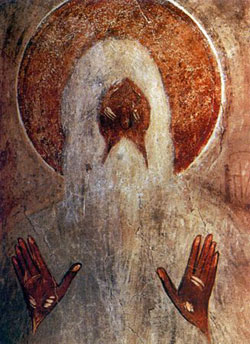
The
Monk Makarios the Great of Egypt was born in the village of Ptinapor
in Lower
Egypt. At the wish of his parents he entered
into marriage, but was soon a widower. Having buried his wife,
Makarios told himself: "Take heed, Makarios, and have care
for thy soul, wherefore it becometh thee to forsake earthly life".
The Lord rewarded the saint with a long life, but from that time
the mindfulness of death was constantly with him, impelling him
to ascetic deeds of prayer and penitence. He began to visit the
church of God more frequently and to be more deeply absorbed
in Holy scripture, but he did not depart from his aged parents – thus
fulfilling the commandment about the honouring of parents. Until
his parents end the Monk Makarios ("Makarios" – from
the Greek means "blessed") used his remaining substance
to help his parents and he began to pray fervently, that the
Lord might shew him a preceptor on the way to salvation. The
Lord sent him such a guide in the person of an experienced monk-elder,
living in the wilderness not far from the village. The elder
took to the youth with love, guided him in the spiritual science
of watchfulness, fasting and prayer, and taught him the handicraft
of weaving baskets. Having built a separate cell not far from
his own, the elder settled his student in it.
The local bishop arrived one day at Ptinapor and, knowing about
the virtuous life of the monk, made him into the clergy against
his will. But Blessed Makarios
was overwhelmed by this disturbance of his silence, and therefore went secretly
to another place. The enemy of salvation began a tenacious struggle with the
ascetic, trying to terrify him, shaking his cell and suggesting sinful thoughts.
Blessed Makarios shook off the attacks of the devil, defending himself with
prayer and the sign of the cross. Evil people made up a slander against the
saint, accusing him in the seduction of a maiden from a nearby village. They
dragged him out of his cell, and jeered at him. The Monk Makarios endured the
temptation with great humility. The money that he got for his baskets he sent
off without a murmur for the welfare of the maiden. The innocence of Blessed
Makarios was revealed when the maiden, being worried for many days, was not
able to give birth. She then confessed in her sufferings that she had slandered
the hermit, and she pointed out the real author of the sin. When her parents
found out the truth, they were astonished and intended to go to the monk with
remorse. But the Monk Makarios, shunning the vexation of people, fled that
place by night and settled on a Nitrian mountain in the Pharan wilderness.
Thus human wickedness contributed to the prospering of the righteous. Having
dwelt in the wilderness for three years, he went to Saint Anthony the Great,
the father of Egyptian monasticism, about whom he had heard that he was still
alive in the world, and he longed with a desire to see him. The Monk Abba Anthony
received him with love, and Makarios became his devoted student and follower.
The Monk Makarios lived with him for a long time and then, on the advice of
the saintly abba, he went off to the Skete wilderness-monastery (in the northwest
part of Egypt). He so shone forth there by his ascetic deeds that he came to
be called "a young-elder", insofar as having scarcely reached thirty
years of age, he distinguished himself as an experienced and mature monk.
The Monk Makarios survived many demonic attacks against him: once he was carrying
palm branches from the wilderness for weaving baskets, and a devil met him
on the way and wanted to strike him with a sickle, but he was not able to do
this and said: "Makarios, I suffer from thee great anguish because I am
not able to vanquish thee; thine armour, by which thou art defended from me,
is this – thy humility". When the saint reached age 40, he was ordained
to the dignity of priest and made the head (abba) of the monks living at the
Skete wilderness. During these years the Monk Makarios often visited with Anthony
the Great, receiving guidance from him in spiritual conversations. Blessed
Makarios was deemed worthy to be present at the death of the holy abba and
he received his staff in succession, together with which he received twice
the spiritual power of Anthony the Great – in the same way, as did once
the prophet Elisha receive from the prophet Elias twice the grace with the
mantle coming down from heaven.
The Monk Makarios accomplished many healings: people thronged to him from various
places for help and for advice, asking his holy prayers. All this unsettled
the quietude of the saint. He therefore dug out under his cell a deep cave
and betook himself there for prayer and Divine meditation. The Monk Makarios
attained to such daring in walking before God, that through his prayer the
Lord resuscitated the dead. In spite of such lofty attainment of God-likeness,
he continued to preserve his unusual humility. One time the holy abba caught
a thief, putting his things on a donkey standing nearby the cell. Not giving
the appearance that he was the owner of these things, the monk began quietly
to help tie up the load. Having removed himself from the world, the monk told
himself: "We bring nothing at all into this world; clearly, it is not
possible to take anything out from hence. Bless the Lord in all things!".
One time the Monk Makarios was walking along the way and, seeing a skull lying
upon the ground, he asked it: "Who art thou?" The skull answered: "I
was a chief-priest of the pagans. When thou, Abba, dost pray for those situated
in hell, we do receive some mitigation". The monk asked: "What are
these torments?" "We are sitting in a great fire, – answered
the skull, – and we do not see one another. When thou prayest, we begin
to see each other somewhat, and this affords us some comfort". Having
heard such words, the monk began weeping and asked: "Are there yet more
fiercesome torments?" The skull answered: "Down below us are located
those, which did know the Name of God, but spurned Him and kept not His commandments.
They endure yet more grievous torments".
Once during prayer Blessed Makarios heard a voice: "Makarios, thou hast
reached such attainment as have two women living in the city". The humble
ascetic, taking up his staff, went to the city, found the house where the women
lived, and knocked. The women received him with joy, and the monk said: "Because
of you I have come from a far wilderness, and I want to know about your good
deeds; tell about them, keeping nothing secret". The women answered with
surprise: "We live with our own husbands, and we have not such virtues".
But the saint continued to insist, and the women then told him: "We entered
into marriage with two brothers by birth. After all this time of life in common
we have told each other not one evil thing nor insulting word, and never do
we quarrel between ourselves. We asked our husbands to release us into a women's
monastery, but they were not agreeable, and we gave a vow not to utter one
worldly word until death". The holy ascetic glorified God and said: "In
truth the Lord does not seek virgins nor married women, and neither monks nor
worldly persons, but doth value the free intent of the person within the arbitrariness
of his free will to offer thanks to the Holy Spirit, which acts and which rules
the life of each person, yearning to be saved".
During the years of the reign of the emperor Valens – an Arian heretic
(364-378), the Monk Makarios the Great together with the Monk Makarios of Alexandria
was subjected to persecution by the adherents of the Arian bishop Luke. They
seized both elders and, imprisoning them on a ship, transported them onto a
wild island where there lived pagans. By the prayers of the saints there, the
daughter of a pagan priest received healing, at which the pagan priest and
all the inhabitants of the island accepted holy Baptism. Learning about what
had happened, the Arian bishop became ashamed and permitted the elders to return
to their own monasteries.
The meekness and humility of the monk transformed human souls. "An harmful
word, – said Abba Makarios, – and it makes good things bad, but
a good word makes bad things good". On the questioning of the monks, how
to pray properly, the monk answered: "For prayer it does not require many
words, it is needful only to say: "Lord, as Thou desirest and as Thou
knowest, have mercy on me". If an enemy should fall upon thee, it is needful
but to utter: "Lord, have mercy!" The Lord knoweth that which is
useful for us, and doth grant us mercy". When the brethren asked: "In
what manner ought a monk to comport himself?", the monk answered: "Forgive
me, I am a poor monk, but I beheld monks being saved in the remote wilderness.
I asked them, how might I make myself a monk. They answered: "If a man
doth not withdraw himself from everything which is situated in the world, it
is not possible to be a monk". At this point I answered: "I am weak
and not able to be such as ye". The monks therewith answered: "If
thou art not able to be such as we, then sit in thy cell and dwell in contrition
about thy sins"."
The Monk Makarios gave advice to a certain monk: "Flee from people and
thou shalt be saved". That one asked: "What does it mean to flee
from people?" The monk answered: "Sit in thy cell and dwell in contrition
about thy sins". The Monk Makarios said also: "If thou wishest to
be saved, be as one who is dead, who is not given over to anger when insulted,
and not puffed up when praised". And further: "If for thyself, slander – is
like praise, poverty – like riches, deficiency – like abundance,
thou shalt not perish. Since it is not possible, that in piety believers and
ascetic seekers should fall into unclean passions and demonic seductions".
The prayer of the Monk Makarios saved many in perilous circumstances of life,
and preserved them from harm and temptation. His benevolence was so great,
that they said about him: "Just as God covereth the world, so also doth
Abba Makarios cover offenses which he, having seen, is as though he had not
seen, and having heard, as though he had not heard".
The monk lived until age 97. Shortly before his end there appeared to him the
Monks Anthony and Pakhomios, bringing the joyful message about his transition
into a blessed Heavenly monastery. Having given admonition to his disciples
and having given them blessing, the Monk Makarios asked forgiveness from all
and bid farewell with the words: "Into Thy hands, Lord, I commend my spirit".
Holy abba Makarios spent sixty years in the wilderness, being dead to the world.
The monk spent most of the time in conversation with God, being often in a
state of spiritual rapture. But he never ceased to weep, to repent and to work.
The abba rendered his rich ascetic experience into profound theological works.
Fifty discourses and seven ascetic tracts form the precious legacy of spiritual
wisdom of the Monk Makarios the Great.
His idea, that the highest blessedness and purpose of man – the unity
of the soul with God – is a primary principle in the works of the Monk
Makarios. Recounting the means by which to attain to mystical union, the monk
relies upon the experience of both the great teachers of Egyptian monasticism
and upon his own experience. The way to God and the experience of the holy
ascetics of Communality with God is revealed to each believer's heart. Therefore
Holy Church also includes within the general use of vespers and matins the
ascetic prayers of the Monk Makarios the Great.
Earthly life, according to the teachings of the Monk Makarios, possesses with
all its works only a relative significance: to prepare the soul, to make it
capable for the perception of the Heavenly Kingdom, to establish in the soul
an affinity with the Heavenly fatherland. "The soul – for those
truly believing in Christ – it is necessary to transpose and to transform
from out of the present degraded condition into another condition, a good condition:
and from out of the present perishing nature into another, Divine nature, and
to be remade anew – by means of the power of the Holy Spirit". To
attain this is possible, if "we truly believe and we truly love God and
have penetrated into all His holy commands". If the soul, betrothed to
Christ on holy Baptism, does not itself co-operate in its gifts of the grace
of the Holy Spirit, then it is subjected to "an excommunication from life",
as is shewn by a lack of attaining blessedness and incapacity to union with
Christ. In the teaching of the Monk Makarios, the question about the unity
of Divine Love and Divine Truth is experientially decided. The inner action
of the Christian determines the extent of the perception by him of this unity.
Each of us acquires salvation through grace and the Divine gift of the Holy
Spirit, but to attain a perfect measure of virtue – which is necessary
for the soul's assimilation of this Divine gift, is possible only "by
faith and by love with the strengthening of free will". Thus, "as
much by grace, as much also by truth" does the Christian inherit eternal
life. Salvation is a Divine-human action: we attain complete spiritual success "not
by Divine power and grace alone, but also by the accomplishing of the proper
labours"; from the other side – it is not alone within "the
measure of freedom and purity" that we arrive at the proper solicitude,
it is not without "the co-operation of the hand of God above". The
participation of man determines the actual condition of his soul, thus self-determining
him to good or evil. "If a soul still in the world does not possess in
itself the sanctity of the Spirit for great faith and for prayer, and does
not strive for the oneness of Divine communion, then it is unfit for the heavenly
kingdom".
The miracles and visions of Blessed Makarios are recorded in a book by the
Presbyter Ruphinos, and his Life was compiled by the Monk Serapion, bishop
of Tmuntis (Lower Egypt), one of the reknown workers of the Church in the IV
Century.
St. Mark, archbishop of Ephesus (1444)
Commemorated on January 19/Januasry 1
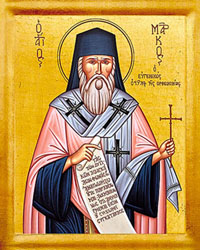
Saint Mark Eugenikes, ArchBishop of Ephesus, was a reknown
defender of Orthodoxy at the Council of Florence. Nothing was
able to sway him towards Uniatism. Secretly slipping away from
Florence, Saint Mark zealously urged the inhabitants of Constantinople
to repudiate the dishonourable concordat. He died in the year
1457.
Venerable Euthymius the Great (473)
Commemorated on January 20/February 2
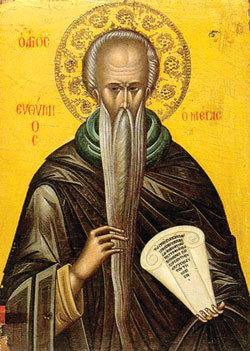
The Monk Euthymios the Great came from the city of Meletina
in Armenia, near the River Euphrates. His parents, Paul and Dionysia,
were illustrious people and pious christians. For a long time
they did not have children, and finally through fervent prayer
a son was born to them, whose appearance into the light of day
was preceded by a Divine apparition foretelling a great future
for the child.
The father of the Monk Euthymios soon died, and his mother – fulfilling
a vow to dedicate her son to God – gave him over for educating to her
brother, the Monk Eudoxios. He presented the lad to the bishop of the Meletina
Church, Otreos, who with love took upon himself caring for him. Seeing his
good conduct, the bishop soon made him a reader. Saint Euthymios later accepted
monasticism and was ordained to the dignity of presbyter. At the same time,
he was entrusted with the stewardship of all the city monasteries. The Monk
Euthymios often visited the monastery of saint Polieuktos, and during the days
of Great Lent he withdrew into the wilderness. The position of steward of the
monasteries weighed heavily upon the ascetic seeking quietude, and in his 30th
year of life he secretly left the city and headed to Jerusalem where, having
prostrated himself before the holy places, he withdrew into the Tharan Lavra.
Having found outside the monastery a solitary empty abode, he settled into
it, securing his subsistence by weaving baskets. Nearby, the Monk Theoktistos
pursued asceticism. They had both one striving for God, one will, one purpose.
Usually after the feast of Theophany, they withdrew into the Kutilleia wilderness
(not far from Jericho). One day though they left there, having chosen a place
in the mountains difficult of access, and settled into a cave. The Lord however
soon revealed their solitary place for the benefit of many people: shepherds
driving their flocks came upon the cave and told about it in the village. People
seeking spiritual benefit began to throng to the hermits. Gradually a monastic
community grew up – several monks came from the Tharan monastery, among
them Marin and Luke. The Monk Euthymios entrusted the running of the growing
monastery to his friend Theoktistos, and himself became a spiritual brother.
He exhorted the brethren: "Know, that one desiring to lead a monastic
life ought not to have his own will, he is always to be found in obedience
and humility and to be mindful of the thought of death, to fear the Judgement
and the eternal fire and to desire the Heavenly Kingdom".
The monk commanded young monastics to tackle bodily labour with an inner thought
of God. "If laymen, – he said, – work much, in order to feed
themselves and their families, and besides this, they give alms and offer sacrifice
to God, then all the moreso ought we as monks to work, so as to avoid idleness
and not be nourished by the work of strangers". The abba demanded, that
the monks keep silence in church during Divine-services and at meals. He did
not allow young monks, wishing to fast more than others of the brethren, to
follow their own will, but urged them to partake of all the food at meals with
temperance, not having over-eaten.
In these years the Monk Euthymios converted and baptised many Arabs, among
whom was the military-head Aspevet and his son Terevon, whom the Monk Euthymios
healed from sickness. Aspevet received the name Peter in Baptism and afterwards
he was a bishop amongst the Arabs.
The fame of the miracles accomplished by the Monk Euthymios spread quickly.
People began to throng from everywhere; brought with sickness, they received
healing. Unable to bear human fame and glory, the monk secretly left the monastery, – taking
with him only his closest student Dometian. He withdrew into the Ruv wilderness
and settled on the high mountain of Mardes, around about the Dead Sea. In the
quests for solitude the monk explored the Zeph wilderness and settled in the
cave, where formerly holy king David hid from the pursuit of king Saul. The
Monk Euthymios founded there a monastery, and at the cave of David he established
a church. During this time the Monk Euthymios converted many monks in the wilderness
from the Manichaean heresy, he worked miracles, healed the sick and cast out
devils.
Visitors to the saint disturbed the tranquillity of the wilderness; loving
silence, he decided to return to the monastery of Saint Theoktistos that he
had forsaken. Along the way the monk took a fancy to a solitary place on a
mountain and he remained on it. There afterwards his holy body was buried.
Blessed Theoktistos went out with his brethren to the Monk Euthymios and requested
him to return to the monastery, but the monk did not comply. However, he promised
to come to the monastery on Sundays for community Divine-services.
The Monk Euthymios did not wish to have anyone nearby, nor to organise a general
monastery or lavra, but in a vision the Lord commanded him not to drive away
those who were come to him for the salvation of their souls. After some time
brethren again gathered around him, and he organised a Lavra, on the pattern
of the Tharan Lavra. In the year 429, when the monk Euthymios was 52 years
old, the Jerusalem Patriarch Juvenalios consecrated the lavra church and supplied
it with presbyters and deacons.
The lavra was at first poor, but the monk steadfastly trusted on God to send
down all the necessities for people. Once there came to the lavra about 400
male pilgrims – Armenians from Jerusalem who were starving. Viewing this,
the Monk Euthymios summoned the steward and ordered him to feed the wanderers.
The steward answered that there was no such quantity of food in the monastery.
The monk, however, persisted. Going to the room where the bread was kept, the
steward found there a large quantity of bread. With this came forth wine and
oil. The wanderers ate to the glory of God: they ate their fill and after this
there remained a three-month supply of food for the brethren. Thus the Lord
wrought a miracle through the faith of Saint Euthymios.
Once one of the monastics refused to carry out an obedience assigned to him.
Despite the fact that the monk having summoned him urged him to comply, the
monastic remained obstinate. The monk then shouted loudly: "Thou wilt
see what the reward for disobedience is". The monastic fell to the ground
in a fit of raving. The brethren began to make entreaty to the abba for him,
and then the Monk Euthymios healed the insubordinate one who, having come to
himself, asked forgiveness and promised to improve himself. "Obedience, – said
Saint Euthymios, – is a great virtue. The Lord loves obedience more than
sacrifice, but disobedience leads to death".
Two of the brethren in the monastery of Saint Euthymios became overwhelmed
by the austere form of life and they resolved to flee. Foreseeing in spirit
their intent, the monk summoned them and for a long time he urged them to give
up their destructive intention. He said: "Heed not that state of mind,
of having sorrow and hatred for the place in which we live, and being prompted
to go off to another place. Let a monk not imagine that, having gone to another
place he arrives at something better, since good deeds are realised not by
a place, but by a firm will and by faith. Whence the tree, which often they
transplant to another place, does not bear fruit".
In the year 431 was convened in Ephesus the Third OEcumenical Council, directed
against the Nestorian heresy. The Monk Euthymios rejoiced over the affirmation
of Orthodoxy but was grieved about the archbishop of Antioch John who, being
orthodox, defended Nestorios.
In the year 451 was convened at Chalcedon the Fourth OEcumenical Council against
the heresy of Dioskoros who, in contrast to Nestorios, asserted that in the
Lord Jesus Christ there is only one nature – the Divine, having in the
Incarnation swallowed up the human nature (thus the heresy was called Monophysite).
The Monk Euthymios accepted the confession of the Chalcedon and he acknowledged
it as Orthodox. News about this spread quickly among the monks and hermits
and many of them, having previously believed wrongly, through the example of
Saint Euthymios accepted the confession of the Chalcedon Council.
For his ascetic life and firm confession of the Orthodox faith Saint Euthymios
received the title "the Great". Having become wearied by intercourse
with the world, the holy abba settled for a time into an inner wilderness.
After his return to the lavra some of the brethren saw that, when he celebrated
the Divine Liturgy, fire descended from Heaven and encircled the saint. The
monk himself revealed to several of the monastics, that often he saw an Angel
celebrating the Holy Liturgy together with him. The monk had a gift of perspicacity – he
saw the innder workings of the spirit and he discerned human inclinations.
When monastics received the Holy Mysteries, it was revealed to the monk – who
approached worthily, and who unto condemnation of self.
When the Monk Euthymios was 82 years old, there came to him blessed Sava (the
future Sava the Sanctified, Comm. 5 December), who was then still a youth.
The elder received him with love and sent him off to the monastery of the Monk
Theoktistos. He foretold, that the Monk Sava would shine in the monastic life.
When the saint had become 90 years of age, his companion and fellow Monk Theoktistos
became grievously ill. The Monk Euthymios came to visit his friend and remained
at the monastery; he took his leave of him and was present at the end. Having
consigned the body to the grave, he returned to the lavra.
The time of his death was revealed to the Monk Euthymios through a particular
mercy of God. On the day of memory of the Monk Anthony the Great, 17 January,
the Monk Euthymios gave blessing to make the all-night vigil and, summoning
the presbyters to the Altar, he told them that he would no more celebrate with
them another vigil, because the Lord was summoning him from earthly life. All
were filled with great sadness, but the monk commanded the brethren to gather
together with him in the morning. He began to instruct the brethren: "If
ye love me, observe my precepts, acquire love, which is an uniting of perfection.
No virtuousness is possible without love and humility. The Lord Himself on
account of His Love for us humbled Himself and became Man, as are we. We need
therefore unceasingly to offer up praise to Him, particularly we, who have
renounced the passions of the world. Never leave from church services, observe
tradition and monastic rules carefully. If anyone of the brethren struggleth
with unclean thoughts, – unceasingly guide and instruct him, so that
the devil does not carry off the brother into the pit".
"I add likewise another command: let the gates of the monastery never be
bolted to wanderers and everything that you have, offer to the needy, for the
poor in their misfortune do what you can to help". Afterwards, having given
instruction for the guidance of the brethren, the monk promised to remain in
spirit with all who desired to bear asceticism in his monastery until the end
of the ages.
Having dismissed all, the Monk Euthymios kept about him only his one disciple
Dometian and, remaining with him inside the Altar for three days, he died on
20 January in the year 473 at the age of 97 years.
At the burial of the holy abba there immediately thronged a multitude of monks
from the monasteries and from the wilderness, among whom was Saint Gerasimos.
The Patriarch Anastasios came also with clergy, the Nitreian monks Martyrios
and Elias, who later became Jerusalem Patriarchs – about which the Monk
Euthymios had foretold them.
Blessed Dometian did not leave the grave of his preceptor for 6 days. On the
7th day, he saw the holy abba, joyously having returned with love for his student: "I
am come, my child, in preparation for thee in peace, wherefore I prayed the
Lord Jesus Christ, that thou be with me". Having told the brethren about
the vision, Saint Dometian went to church and in joy offered his spirit to
God. He was buried alongside Saint Euthymios. The relics of the Monk Euthymios
were situated at his monastery in Palestine.
Venerable Maximus the Confessor (662)
Commemorated on January 21/January 3
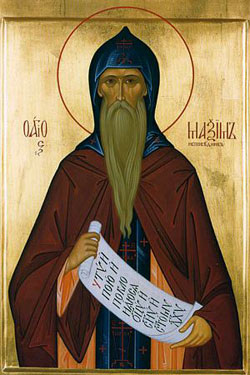
The
Monk Maximos the Confessor was born in Constantinople in about
the
year
580 and raised in a pious Christian family. In
his youth he received a very diverse education: he studied philosophy,
grammatics, rhetoric, he was well-read in the authors of antiquity
and he mastered to perfection theological dialectics. When Saint
Maximos entered into government service, the scope of his learning
and his conscientiousness enabled him to become first secretary
to the emperor Heraclius (611-641). But court life vexed him,
and he withdrew to the Chrysopoleia monastery (on the opposite
shore of the Bosphorus – now Skutari), where he accepted
monastic tonsure. By the humility of his wisdom he soon won the
love of the brethren and was chosen hegumen of the monastery,
but even in this dignity, in his own words, he "remained
a simple monk". But in 633 at the request of a theologian,
the future Jerusalem Patriarch Saint Sophronios (Comm. 11 March),
the Monk Maximos left the monastery and set off to Alexandria.
Saint Sophronios was known in these times as an implacable antagonist
against the Monothelite heresy. The Fourth OEcumenical Council
(year 451) had condemned
the Monophysite heresy, which confessed in the Lord Jesus Christ only one nature
(the Divine, but not the Human nature, of Christ). Influenced by this erroneous
tendency of thought, the Monothelite heretics introduced the concept that in
Christ there was only "one Divine will" ("thelema") and
only "one Divine effectuation or energy" ("energia"), – which
sought to lead back by another path to the repudiated Monophysite heresy. Monotheletism
found numerous adherents in Armenia, Syria, Egypt. The heresy, fanned also
by nationalist animosities, became a serious threat to church unity in the
East. The struggle of Orthodoxy with the heresies was particularly complicated
by the fact, that in the year 630 three of the Patriarchal thrones in the Orthodox
East were occupied by Monothelites: at Constantinople – by Sergios, at
Antioch – by Athanasias, and at Alexandria – by Cyrus.
The path of the Monk Maximos from Constantinople to Alexandria led through
Crete, where indeed he began his preaching activity. He clashed there with
a bishop, who adhered to the heretical opinions of Severus and Nestorius. At
Alexandria and its surroundings the monk spent about 6 years. In 638 the emperor
Heraclius, together with the patriarch Sergios, attempted to downplay the discrepancies
in the confession of faith, and the issued an edict: the so-called "Ecthesis" ("Ekthesis
tes pisteos" – "Exposition of Faith), – which ultimately
decreed that there be confessed the teaching about "one will" ("mono-thelema")
operative under the two natures of the Saviour. In defending Orthodoxy against
this "Ecthesis", the Monk Maximos recoursed to people of various
vocations and positions, and these conversations had success. "Not only
the clergy and all the bishops, but also the people, and all the secular officials
felt within themselves some sort of invisible attraction to him, – testifies
his Vita.
Towards the end of 638 the patriarch Sergios died, and in 641 – the emperor
Heraclius also died. The imperial throne came to be occupied by the cruel and
coarse Constans II (642-668), an open adherent of the Monothelites. The assaults
of the heretics against Orthodoxy intensified. The Monk Maximos went off to
Carthage and he preached there and in its surroundings for about 5 years. When
the successor of patriarch Sergios, patriarch Pyrrhos, arrived there in forsaking
Constantinople because of court intrigues, and being by persuasion a Monothelite, – there
occurred between him and the Monk Maximos an open disputation in June 645.
The result of this was that Pyrrhos publicly acknowledged his error and even
wanted to put into writing to Pope Theodore the repudiation of his error. The
Monk Maximos together with Pyrrhos set off to Rome, where Pope Theodore accepted
the repentance of the former patriarch and restored him to his dignity.
In the year 647 the Monk Maximos returned to Africa. And there, at a council
of bishops Monotheletism was condemned as an heresy. In the year 648, in place
of the "Ecthesis", there was issued a new edict, commissioned by
Constans and compiled by the Constantinople patriarch Paul, the "Typus" ("Tupos
tes pisteos" – "Pattern of the Faith"), which overall
forbade any further deliberations, whether if be about "one will" or
about "two wills", as regarding the acknowledged "two natures" of
the Lord Jesus Christ. The Monk Maximos thereupon turned to the successor of
the Roman Pope Theodore, Pope Martin I (649-654), with a request to examine
the question of Monotheletism at a conciliar consideration by all the Church.
In October of 649 there was convened the Lateran Council, at which were present
150 Western bishops and 37 representatives of the Orthodox East, amongst which
was also the Monk Maximos the Confessor. The Council condemned Monotheletism,
and its defenders – the Constantinople patriarchs Sergios, Paul and Pyrrhos,
were consigned to anathema.
When Constans II received the determinations of the Council, he gave orders
to arrest both Pope Martin and the Monk Maximos. This summons took 5 years
to fulfill, in the year 654. They accused the Monk Maximos of treason to the
realm and locked him up in prison. In 656 he was sent off to Thrace, and again
later brought back to a Constantinople prison. The monk, together with two
of his students, was subjected to the cruellest torments: for each they cut
out the tongue and cut off the right hand. Then they were sent off to Colchis.
But here the Lord worked an inexplicable miracle: all three of them found the
ability to speak and to write. The Monk Maximos indeed foretold his own end
(+ 13 August 662). On the Greek Saints-Prologue (Calendar), 13 August indicates
the Transfer of the Relics of Saint Maximos to Constantinople, but possibly
it might apply to the death of the saint. Or otherwise, the establishing of
his memory under 21 January may be connected with this – that 13 August
celebrates the Leavetaking of the Feast of the Transfiguration of the Lord.
Over the grave of the Monk Maximos shone three miraculously-appearing lights,
and there occurred many an healing.
The Monk Maximos has left to the Church a large theological legacy. His exegetical
works contain explanations of difficult places within the Holy Scripture, also
Commentary on the Prayer of the Lord and on the 59th Psalm, various "scholia" ("marginalia" or
text-margin commentaries) on treatises of the PriestMartyr Dionysios the Areopagite
(+ 96, Comm. 3 October) and Sainted Gregory the Theologian (+ 389, Comm. 25
January). To the exegetical works of Saint Maximos belongs likewise his explication
of Divine-services, entitled "Mystagogia" ("Introduction concerning
the Mystery").
To the dogmatic works of the Monk Maximos belong: the Exposition on his dispute
with Pyrrhos, and several tracts and letters to various people. In them are
contained expositions of the Orthodox teaching of the Divine Essence and about
Hypostatic-Persons of the Holy Trinity, about the Incarnation of God, and about
the "theosis" ("deification", "obozhenie") of
human nature.
"Nothing in theosis is the product of human nature, – the Monk Maximos
writes in a letter to his friend Thalassios, – since nature cannot comprehend
God. It is only but the mercy of God that has the capacity to endow theosis unto
the existing... In theosis man (the image of God) becomes likened to God, he
rejoices in all the plenitude that does belong to him by nature, since the grace
of the Spirit doth triumph within him and because God doth act within him" (Letter
22).
To the Monk Maximos belong also works concerning the anthropologic (i.e. concerning
man). He deliberates on the nature of the soul and its consciously-personal
existence after the death of a man. Among his moral compositions, especially
important is his "Chapters on Love". The Monk Maximos the Confessor
wrote likewise three hymns in the finest traditions of church hymnography,
following the lead of Saint Gregory the Theologian.
The theology of the Monk Maximos the Confessor, based on the spiritual experience
of the knowledge of the great Desert-Fathers, and utilising the skilled art
of dialectics worked out by pre-Christian philosophy, was continued and developed
upon in the works of the Monk Simeon the New Theologian (+ 1021, Comm. 12 March),
and Sainted Gregory Palamas (+ c. 1360, Comm. 14 November).
Apostle Timothy of the Seventy (ca. 96)
Commemorated on January 22/February 4
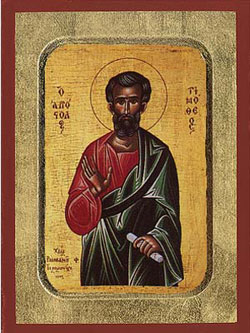
The
Holy Disciple Timothy was from the Lycaonian city of Lystra in
Asia
Minor.
Saint Timothy was converted to Christ in the year
52 by the holy Apostle Paul (+ c. 67, Comm. 29 June). When the
Apostle Paul and Barnabas first visited the Lycaonian cities,
the Apostle Paul at Lystra healed one crippled from birth; many
of the inhabitants there then believed in Christ, and among them
was the future youthful disciple Timothy, his mother Eunice and
grandmother Loida (Lois) (Acts 14: 6-12; 2 Tim. 1: 5). The seed
of faith, planted in the soul of Saint Timothy by the Apostle
Paul, brought forth abundant fruit. He became a zealous student
of the Apostle Paul, and later his constant companion and co-worker
in the preaching of the Gospel. The Apostle Paul loved Saint
Timothy and in his Epistles called him his beloved son, with
gratitude remembering his devotion and fidelity. He wrote to
Timothy: "Thou hast followed me in teaching, in life, in
disposition, faith, magnanimity, love, and patience in afflictions
and sufferings..." (2 Tim. 3: 10-11). The Apostle Paul in
the year 65 ordained Saint Timothy as bishop of the Ephesus Church,
which the saint administered for 15 years. And finally the holy
Apostle Paul, situated in prison and knowing, that the act of
martyrdom was before him, summoned his faithful student and friend,
the Disciple Timothy, for a last farewell (2 Tim. 4: 9).
Saint Timothy ended his life as a martyr. At Ephesus the pagans made a feastday
in honour of their idols and they carried them through the city, accompanied
by impious ceremonies and songs. The holy Bishop Timothy, zealous for the glory
of God, attempted to halt the procession and reason with the spiritually blind
idol-worshipping people, by preaching the true faith in Christ. The pagans
dashed angrily upon the holy disciple, they beat him, dragged him along the
ground, and finally, they stoned him. The holy Disciple Timothy's death by
martyrdom occurred in the year 80. In the IV Century the holy relics of the
Disciple Timothy were transferred to Constantinople and placed in the church
of the Holy Apostles. Holy Church venerates Saint Timothy as amongst the number
of the Seventy Disciples.
Hieromartyr Clement, bishop of Ancyra
Commemorated on January 23/February 5
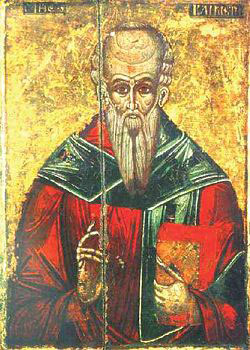
The PriestMartyr Clement was born in the Galatian city of Ancyra
in the year 258, from a pagan father and a Christian mother.
In infancy he lost his father, and at twelve years of age also
his mother, who predicted for him a martyr's death for belief
in Christ. A woman adopting him named Sophia raised him in the
fear of God. During the time of a terrible famine in Galatia
several pagans cast out their own children, not having the wherewithal
to feed them, and Sophia gathered up also these hapless ones,
she fed and clothed them, and Saint Clement assisted her in this.
He taught the children and prepared them for Holy Baptism. Many
of them died as martyrs for the faith in Christ.
For his virtuous life Saint Clement was made a reader, and later a deacon,
and at age eighteen he received the dignity of presbyter, and at age twenty
he was ordained bishop of Ancyra. Soon afterwards there flared up the persecution
against Christians under Diocletian (284-305). Bishop Clement was arrested
under denunciation and had also to answer for himself. The governor of Galatia,
Dometian, tried to sway the saint to the worship of the pagan gods, but Saint
Clement firmly confessed his faith and valiantly endured all the tortures,
which the cruel official subjected him to. They suspended him on a tree, and
tore at his body such that the bare bones could be seen, they struck him fiercely
with clubs and stones, and they turned him about on a wheel and burned at him
with a low fire. The Lord preserved His sufferer and healed his lacerated body.
Then Dometian dispatched the saint to Rome to the emperor Diocletian himself,
with a report that Bishop Clement had been fiercely tortured, but had proven
unyielding. Diocletian, seeing the martyr completely healthy, did not believe
the report and subjected him to still yet crueler tortures, and then had him
locked up in prison.
Many of the pagans, seeing the bravery of the saint and the miraculous healing
of his wounds, believed in Christ. People flocked to Saint Clement in prison
for guidance, healing and Baptism, such that the prison was literally transformed
into a church.Many of these people, when reported about, were executed by the
emperor. Diocletian, struck by the amazing endurance of Saint Clement, sent
him off to Nicomedia to his co-emperor Maximian.
On the ship along the way, the saint was joined by his disciple Agathangelos,
who had avoided being executed with the other confessors, and who now wanted
to suffer and die for Christ together with Bishop Clement.
The emperor Maximian in turn sent off Saint Clement and Agathangelos to the
governor Agrippina, who subjected them to such inhuman torments, that even
among the pagan on-lookers there was felt a sense of pity for the martyrs and
they began to pelt the torturers with stones.
Having been set free, the saints healed an inhabitant of the city with a laying
on of hands and they baptised and instructed people, thronging to them in multitudes.
Arrested again on orders of Maximian, they were sent off home to the city of
Ancyra, where the Ancyra prince Cyrenius had them put to torture, and then
dispatched them off to the city of Amasia to the official Dometius, known for
his especial cruelty.
In Amasia the martyrs were thrown into molten lime, they spent a whole day
in it and remained unharmed. They flayed their skin, beat them with iron rods,
they set them on red-hot beds and poured sulfur. All this failed to harm the
saints, and they were sent off to Tarsis for new tortures. In the wilderness
along the way Saint Clement in prayer had a revelation, that he would suffer
another 28 years for the Name of Christ. And then having endured a multitude
of tortures, the saints were locked up in prison.
After the death of Maximian, Saint Agathangelos was beheaded with the sword.
Ancyra Christians set free Saint Clement from prison and they took him to a
cave church. There, after celebrating Liturgy, the saint announced to the faithful
the soon impending end of the persecution and his own approaching demise. The
holy martyr soon actually was killed by soldiers from the city, who stormed
the church. They beheaded the saint during the time of his offering the Bloodless
Sacrifice (+ c. 312).
Venerable Xenia of Rome and her two female slaves (5th c.)
Commemorated on January 24/February 6
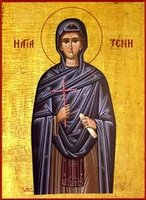
The
Nun Xenia (V), in the world Eusebia, was the only daughter of
an
eminent Roman
senator. From her youth she yearned for God.
In order to evade the marriage set up for her, she secretly left
from her parental home together with two servants devoted to
her and they set sail upon a ship. Through the Providence of
God meeting up with the head of the monastery of the holy Apostle
Andrew, which was situated in the city of Milassa, in Caesarea,
she besought him to take her with her companions to Milassa.
Having changed her name, she called herself Xenia [which in Greek
means "stranger" or foreigner"]. At Milassa she
bought land, built a church in the name of Saint Stephen and
founded a woman's monastery. Soon after this the bishop of Milassa,
Paul, consecrated Xenia a deaconess, as fully worthy of that
calling through virtuous life. The saint rendered aid to all:
for the destitute she was a benefactress, for the grief-stricken – a
comforter, for sinners – a guide. She possessed deep humility,
accounting herself worst and most sinful of all. In her ascetic
deeds she was guided by the counsels of the Palestinian ascetic,
the Monk Euthymios. By her lofty life Saint Xenia attracted many
a soul to salvation. The death of the holy virgin, during a time
of prayer, was marked by the Lord with the appearance over the
monastery in the heavens of an apparition in the form of a luminous
crown with a radiant cross amidst it, which accompanied the body
of the saint when it was carried into the city to the people,
and it stayed until the moment of burial. Many of the sick, having
touched to the remains of the saint, received healing.
St. Gregory the Theologian, archbishop of Constantinople (389)
Commemorated on January 25/February 7
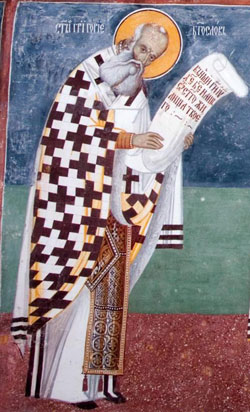
Sainted
Gregory (Nazianzus) the Theologian, Archbishop of Constantinople,
an ecumenical
father and teacher of the Church, was born into
a Christian family of eminent lineage in the year 329, at Arianzos
(not far from the city of Cappadocian Nazianzos). His father,
likewise a Sainted Gregory, was Bishop of Nazianzos (Comm. 1
January); but of these two father and son, the son is the Saint
Gregory Nazianzus encountered in Patristic theology. His mother,
Saint Nonna (+ 374, Comm. 5 August), prayed God for a son, having
given a vow to dedicate him to the Lord. As was revealed to her
in a dream, she accordingly named her first-born Gregory. When
the son learned to read, his mother presented him with the Holy
Scripture. Saint Gregory received a quite complete and extensive
education: after working at home with his uncle Saint Amphylokhios,
an experienced teacher of rhetoric, he then studied in the schools
of Nazianzos, Caesarea Cappadocia and Alexandria. Then for the
finishing touches to his education, the saint set off to Athens.
On the way from Alexandria to Hellas [Greek name for Greece]
(352), during the time of a terrible storm of many days, he was
apprehensive only that "the murderous waters would deprive
him of the waters of cleansing". "For twenty days and
nights, – relates Saint Gregory, – I lay at the ship's
stern, beseeching the merciful God for salvation, and at this
perilous time I gave a vow to dedicate myself to God, being saved
through this vow".
The saint spent six years at Athens, and there studied rhetorics,
poetics, geometry and astronomy. His teachers were the reknown
pagan rhetoricians Gymorias
and Proeresias. Together with Saint Gregory, there also studied there Saint
Basil, the future Archbishop of Caesarea Cappadocia (+ 379, Comm. 1 January).
Their friendship, formed while still back in school in Caesarea, flourished
in a deep spiritual closeness. But their acquaintance with Julian, the future
emperor (361-363) – and apostate from the Christian faith, soon turned
into implacable enmity.
Upon completing his education, Saint Gregory remained for a certain while at
Athens and taught the rhetoric eloquence of speech. He knew well the pre-Christian
pagan philosophy and literature.
In the year 358 Saint Gregory quietly quit Athens and returned to his parents
at Nazianzos. And here he at almost 30 years of age received Baptism from his
father. Since now it was for him "become more significant to be a follower
of God, than foremost with the emperor", he vacillated only on which way
was to be "the preference: contemplative or practical".
At the suggestion of Saint Basil he withdrew into the wilderness, so as to
asceticise alongside him.
But at the demand of his father, Saint Gregory returned to Nazianzos in 361
and received the dignity of presbyter. Sensing however, that solitude and silent
prayer were immeasurably closer to his liking than pastoral activity, Saint
Gregory again hastened into the wilderness to Saint Basil. There in the wilderness
he strengthened in spirit, found the wherewithal to return to his flock and
properly do his duty. And there soon befell Saint Gregory the hard task of
reconciling the bishop with his flock, which condemned their pastor for signing
an ambiguous interpretation of the dogmas of the faith. Saint Gregory gave
the flock time for expression of feelings first, and then he convinced his
father to openly acknowledge his mistake. After this, and uttering a sermon
on the need for reconciliation, Saint Gregory accomplished his intent. Sainted
Basil the Great made Saint Gregory bishop of the city of Sasima, but in order
to assist his dying father, Saint Gregory remained at Nazianzos, and for a
certain while after the death of his father he guided the flock of this city.
Upon the death of the Constantinople patriarch Valentus in the year 378, the
Antioch Council invited Saint Gregory to help the Constantinople Church, which
at this time moreso than at others was ravaged by heretics. Having received
the consent of Saint Basil the Great, Saint Gregory came to Constantinople
upon the Patriarchal throne. In the year 379 he began to serve and preach in
a not-large house church of his kinsmen. He named this church "Anastasis" ("Voskresenie" or "Resurrection"),
believing that in this small church he would begin to resurrect Orthodoxy.
Heretics ruled everywhere – whether they be Arians or Appolinarians.
And the more loudly resounded his preaching, the more fully increased the gathering
in church, and by this more bitterly grew the opposition of the heretics. On
the night of Pascha 21 April 379, when Saint Gregory was making Baptism of
the newly-illumined, a mob of armed heretics burst into the church and showered
an hail of rocks upon the Orthodox, killing one bishop and wounding Saint Gregory.
But the fortitude and mildness of the saint were his best armour, and his words
regathered the Orthodox.
The compiled works of Saint Gregory – discourses, letters, verses – all
show, that he strove to be a worthy preacher of the truth of Christ. A gift
of words was bestown him, and the saint sought to offer it in gift to God – the
Word: ""This gift offer I up to my God, this gift I do dedicate to
Him: – this alone, is what I have remaining as my riches; I gave up all
else at the command of the Spirit; everything that I had, I gave in exchange
for the pearl of great price. Only in words do I master it, as a servant of
the Word; never intentionally would I wish to disdain this wealth, I esteem
it, I set value by it, I am comforted by it more, than others are comforted
by all the treasures of the world. It – is the companion of all my life,
a good counselor and converser; a guide on the way to Heaven and a fervent
co-ascetic". In order to worthily preach the Word of God, the saint assiduously
prepared and revised his works.
In five Sermons – "Discourses on Theology", dealing with those
inclined towards the verbose reasonings of Eunomios, Saint Gregory first of
all gives a precise definition, who it is from whom and when that they can
theologise. Only those who are experienced can properly reason about God, those
successful at contemplation and, foremost of all, pure in soul and body, or
in utmost measure cleansed of self. To reason about God properly is possible
only for one who enters into it with fervour and reverence. Explaining, that
God has concealed His Essence from mankind, Saint Gregory demonstrates, that "by
means of flesh it is impossible to view mental objects without admixture of
the corporeal". To theologise talking about God in a positive sense is
possible only when we become free from the external impressions of things and
from their affects, when our guide – the mind, does not adhere to impure
transitory images. Answering the Eunomians, who would presuppose by means of
logical speculation to grasp at the Essence of God, the saint declared that
man perceives God, when he is commensurate in form with the Divine Principle,
i.e. when the mind co-unites with the commensurate Essence. Furthermore, the
example of the Old Testament patriarchs and prophets and also the Apostles
has demonstrated, that for earthly man the Essence of God is incomprehensible.
Saint Gregory cited by way of example the futile sophistry of Eunomios: "God
begat the Son either through His will, or contrary to will. If He begat contrary
to will, then He underwent constraint. If by His will, then the Son is the
Son of His intent".
Confuting suchlike reasoning, Saint Gregory points out the harm done by it
to man: "Thou thyself, who speaketh so thoughtlessly, hast thou issued
forth by intent or not by the intent of thy father? If not by intent, then
also thy father underwent compulsion in it. From whom? To demonstrate this
in nature thou cannot: it would favour chasteness. And if by intent, then on
account of a few syllables thou dost deprive thyself of thy father; wherein
thou dost make thyself a son by self intent, rather than of thy father".
Saint Gregory then turns himself to Holy Scripture, with particular attention
examining a place, where it points out the Divine Nature of the Son of God.
The repetitive interpretations of Saint Gregory on Holy Scripture are devoted
to revealing the thought, that the Divine power of the Saviour was actualised
even when on account of the Salvation of mankind He took upon Himself an impaired
human nature. But another place in these Sermons of Saint Gregory is occupied
by polemics against the Eunomians for their blaspheming of the Holy Spirit.
Closely examining everything that is said in the Gospel about the Third Person
of the MostHoly Trinity, the saint refutes the heresy of Eunomios, which rejected
the Divinity of the Holy Spirit. He comes to two fundamentally posited results.
First, in reading Holy Scripture, it is necessary to reject blind literalism
and to study so as to perceive its spiritual sense. Second, in the Old Testament
the Holy Spirit operated hiddenly. In the New Testament "the Holy Spirit
doth reside with us and in most evident form doth disclose Itself before us.
As long as they did not acknowledge God the Father, they could not properly
preach about the Son, and as long as they did not accept the Son, they could
not, expressing it somewhat boldly, additionally burden us with the Holy Spirit.
The Divinity of the Holy Spirit – is a sublime subject. Here before us
is a mass of testimony. Christ is born – the Holy Spirit precedes this;
Christ is baptised – the Spirit witnesses to this; Christ works miracles – the
Spirit collaborates; Christ ascends – the Spirit comes in place of Him.
And what indeed is great and Divine, that He is not capable of? What Name,
appertaining to Divinity, does not apply to Him, except for UnBegotten and
Begotten?...I am amazed, when I see such a richness of titles, – I tremble
when I consider, which Name it is they do blaspheme, they who do so revolt
against the Spirit!"
The content of the Sermons of Saint Gregory does not consist in this alone.
He wrote also: five laudatory tracts, ten interpretations of feastdays, two
discourses of reproach against Julian the Apostate – "two pillars,
on which is indelibly written the impiety of Julian for posterity", and
preachings on other themes. In all, 45 sermons of Saint Gregory have been preserved.
The letters of the saint compare with his best theological works. All of them
are masterfully elaborated while yet brief, for the most part. In his hymns
as in everything, Saint Gregory lived for Christ. "If the lengthy tracts
of the heretics, – be indeed new psalters, at variance with David, and – the
pretty verses they honour be as a third testament: then we also shalt sing
psalms, and begin to write much and compose poetic metres", – said
the saint. About his poetic gift the saint wrote thus: "I – am an
organ of the Lord and sweetly by intricacy of song of the MostHigh I do glorify
the King: all atremble before Him".
The fame of the Orthodox preacher spread through East and West. But the saint
lived in the very capital just as though he lived still in the wilderness – "his
food was food of the wilderness; his clothing – whatever necessary; his
making of rounds was without pretense, and being in proximity of the court – he
sought nothing from the court". During a time of sickness the saint was
given a shock. One whom he reckoned as his friend, the philosopher Maximos,
was consecrated in place of Saint Gregory at Constantinople. Struck by the
ingratitude of Maximos, the saint decided to resign the cathedra, but his faithful
flock restrained him from it. The people threw the usurper out of the city.
On 24 November 380 the holy emperor Theodosius arrived in the capital and,
in enforcing his decree against the heretics, the chief church was returned
to the Orthodox, with Saint Gregory solemnly making entrance. Soon an attempt
on the life of Saint Gregory was in the offing, but the one who was to be the
assassin instead appeared before the saint with tears of repentance.
In the year 381 at the Second OEcumenical Council, Saint Gregory was confirmed
in the dignity of Constantinople Patriarch. Upon the death of the Antioch Patriarch
Meletios, Saint Gregory presided at the Council. Hoping to reconcile the West
with the East, he offered to recognise Paulinos as Antioch Patriarch. But with
the arrival of those who earlier had acted against Saint Gregory on the side
of Maximos – particularly Egyptian and Macedonian bishops, they did not
want to acknowledge the saint as Patriarch of Constantinople. Saint Gregory
decided to sacrifice himself for the peace of the Church: "Let me be as
the Prophet Jonah! I was guilty for the storm, but I would sacrifice myself
for the salvation of the ship. Grab hold and throw me... I was not happy when
I ascended the throne, and gladly would I descend it". Having explained
to the emperor about his wish to quit the capital, Saint Gregory appeared again
at the Council, in a farewell address asking it to let him depart in peace.
Upon his return to his native region, Saint Gregory concerned himself about
the incursion of Appolinarian heretics into the Nazianzos flock, and he established
there as bishop the pious Eulalios, while he himself withdrew into the solitude
of Arianzos so dear to his heart. Not forsaking the wilderness, the saint with
zeal for the truth of Christ continued to affirm Orthodoxy through his letters
and verses. In the year 389 he died, on 25 January, being honoured by the Church
with the title "Theologian" bestown also on that beloved disciple
of Christ – the holy Evangelist and Apostle John.
"I want to speak boldly and forcefully, so that ye may be made the best,
so that ye may turn from flesh to spirit, so that in right manner ye progress
in spirit", – said Saint Gregory the Theologian.
In his works Saint Gregory, just like that other Theologian Saint John, directs
everything towards the Praeternal Word. The Monk John Damascene (Comm. 4 December),
in the first part of his book "Exposition on the Faith", followed
the lead of Saint Gregory the Theologian.
The body of Saint Gregory was buried at Nazianzos. In the year 950 the holy
relics were transferred to Constantinople into the church of the Holy Apostles.
Later on part of the relics were transferred to Rome. Tradition has preserved
the features of the saint as: "a face humble, pale, eyebrows standing
up thick, a meek glance, beard not long, but thick and broad". His contemporaries
already called the archpastor a saint. The Orthodox Church, terming Saint Gregory
a second Theologian and mystery-insightful luminous writer of the Holy Trinity,
recourses thus to him in the songs of Divine-services: "By the theology
of thy tongue rhetoric wrangling is undone, O glorious one, thou hast adorned
the Church with the fabric of Orthodoxy woven from on high: rejoice, O father,
thou utmost mind Theological". [from Kondak].
Translation of the relics (437) of St. John Chrysostom, archbishop
of Constantinople
Commemorated on January 27/February 9
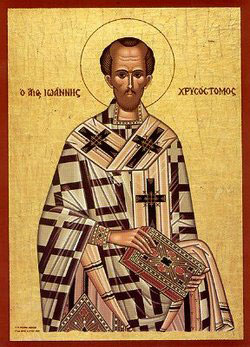
Sainted
John Chrysostom – a
great ecumenical teacher and hierarch, died in the city of
Comene in the year 407 on his
way to a place of exile, having been condemned by the intrigues
of the empress Eudoxia because of his daring denunciation of
the vices ruling over Constantinople. The transfer of his venerable
relics was made in the year 438: after 30 years following the
death of the saint during the reign of Eudoxia's son emperor
Theodosius II (408-450).
Saint John Chrysostom had the warm love and deep respect of the
people, and grief over his untimely death lived on in the hearts
of christians. Saint John's
student Saint Proclus, Patriarch of Constantinople (434-447), making Divine-services
in the Church of Saint Sophia, preached a sermon which in glorifying Saint
John he said: "O John! Thy life was filled with difficulties, but thy
death was glorious, thy grave is blessed and reward abundant through the grace
and mercy of our Lord Jesus Christ. O graced one, having conquered the bounds
of time and place! Love hath conquered space, unforgetting memory hath annihilated
the limits, and place doth not hinder the miracles of the saint". Those
who were present in church, deeply touched by the words of Saint Proclus, did
not allow him even to finish his sermon. With one accord they began to entreat
the Patriarch to intercede with the emperor, so that the relics of Saint John
might be transferred to Constantinople. The emperor, overwhelmed by Saint Proclus,
gave his consent and made the order to transfer the relics of Saint John. But
the people dispatched by him were by no means able to lift up the holy relics – not
until that moment when the emperor realising his oversight that he had not
sent the message to Saint John, humbly beseeching of him forgiveness for himself
and for his mother Eudoxia. The message was read at the grave of Saint John
and after this they easily lifted up the relics, carried them onto a ship and
arrived at Constantinople. The reliquary coffin with the relics was placed
in the Church of the holy Martyr Irene. The Patriarch opened the coffin: the
body of Saint John had remained without decay. The emperor, having approached
the coffin with tears, asked forgiveness. All day and night people did not
leave the coffin. In the morning the reliquary coffin with its relics was brought
to the Church of the Holy Apostles. The people cried out: "Receive back
thy throne, father!" Then Patriarch Proclus and the clergy standing at
the relics – saw Saint John open his mouth and pronounce: "Peace
be to all".
In the IX Century the feastday in honour of the transfer of the relics of Sainted
John Chrysostom was written into church singing.
Venerable Ephraim the Syrian (373)
Commemorated on January 28/January 9
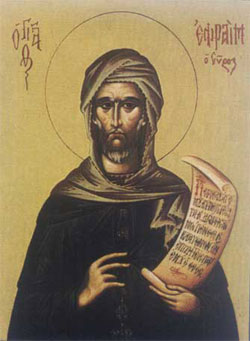
The Monk Ephrem the Syrian, a teacher of repentance, was born
at the beginning of the IV Century (his precise year of birth
is unknown) in the city of Ninevah (Mesopotamia) into the family
of impoverished toilers of the soil. His parents raised their
son in piety. But from the time of his childhood he was known
for his quick temper and irascible character, and in his youth
he often had fights, he acted thoughtlessly, and even doubted
of God's Providence, until he finally recovered his senses from
the Lord's doing, guiding him on the path of repentance and salvation.
One time he was unjustly accused of the theft of a sheep and
was thrown into prison. And there in a dream he heard a voice,
calling him to repentance and rectifying his life. After this,
he was acquitted of the charges and set free.
Within Ephrem there took place a deep repentance. The youth withdrew
outside the city and became an hermit. This form of Christian
asceticism had been introduced
at Ninevah by a disciple of the Monk Anthony the Great, – the Egyptian
Wilderness-Dweller Eugenios (Eugene).
Among the hermits especially prominent was the noted ascetic, a preacher of
Christianity and denouncer of the Arians, the bishop of the Ninevah Church,
Saint James (Comm. 13 January). The Monk Ephrem became one of his disciples.
Under the graced guidance of the holy hierarch, the Monk Ephrem attained to
Christian meekness, humility, submission to the Will of God, and the strength
without murmur to undergo various temptations. Saint James knew the high qualities
of his student and he used them for the good of the Ninevah Church – he
entrusted him to read sermons, to instruct children in the school, and he took
Ephrem along with him to the First OEcumenical Council at Nicea (in the year
325). The Monk Ephrem was in obedience to Saint James for 14 years, until the
bishop's death.
After the capture of Ninevah by the Persians in the year 363, the Monk Ephrem
abandoned the wilderness and settled in a monastery near the city of Edessa.
Here he saw many a great ascetic, passing their lives in prayer and psalmody.
Their caves were solitary shelters, and they fed themselves off a certain plant.
He became especially close with the ascetic Julian (Comm. 18 October), who
was one with him in a spirit of repentance. The Monk Ephrem combined with his
ascetic works an incessant study of the Word of God, gathering within it for
his soul both solace and wisdom. The Lord gave him a gift of teaching, and
people began to come to him, wanting to hear his guidances, which produced
a particular effect upon the soul, since he began with self-accusation. The
monk both verbally and in writing instructed everyone in repentance, faith
and piety, and he denounced the Arian heresy, which during those times was
disrupting Christian society. And pagans likewise, listening to the preaching
of the monk, were converted to Christianity.
He also toiled no little at the interpretation of Holy Scripture – with
an explication of the Pentateuch (i.e. "Five Books") of Moses. He
wrote many a prayer and church-song, thereby enriching the Church's Divine-services.
Famed prayers of Saint Ephrem are to the MostHoly Trinity, to the Son of God,
and to the MostHoly Mother of God. He wrote for his Church song for the Twelve
Great Feastdays of the Lord (the Nativity of Christ, the Baptism, the Resurrection),
and funereal song. Saint Emphrem's Prayer of Repentance, "O Lord and Master
of my life...", is said during Great Lent, and it summons Christians to
spiritual renewal. The Church since times ancient valued highly the works of
the Monk Ephrem: his works were read in certain churches, at gatherings of
the faithful, after the Holy Scripture. And now at present in accord with the
Church Ustav (Rule), certain of his instructions are prescribed to be read
on the days of Lent. Amidst the prophets, Saint David is pre-eminently the
psalmodist; amidst the holy fathers of the Church the Monk Ephrem the Syrian – is
pre-eminently a man of prayer. His spiritual experience made him a guide to
monks and an help to the pastors of Edessa. The Monk Ephrem wrote in Syrian,
but his works were very early translated into the Greek and Armenian languages,
and from the Greek – into the Latin and Slavonic languages.
In numerous of the works of the Monk Ephrem are encountered glimpses of the
life of the Syrian ascetics, the centre of which involved prayer and with it
thereupon the toiling for the common good of the brethren, in the obediences.
The outlook of the meaning of life among all the Syrian ascetics was the same.
The end purpose of their efforts was considered by the monks to be communality
with God and the diffusion of Divine grace within the soul of the ascetic;
the present life for them was a time of tears, fasting and toil.
"If the Son of God be within thee, then also His Kingdom is within thee.
Here then is the Kingdom of God – within thee, a sinner. Go inwards into
thine self, search diligently and without toil thou shalt find it. Outside of
thee – is death, and the door to it – is sin. Go inwards into thine
self, dwell within thine heart, for since there – is God". Constant
spiritual sobriety, the developing of good within the soul of man gives unto
him the possibility to take upon himself a task like blessedness, and a self-constraint
like sanctity. The requital is presupposed in the earthly life of man, it is
an undertaking by degrees of its spiritual perfection. Whoso grows himself wings
upon the earth, says the Monk Ephrem, is one who soars up into the heights; whoso
down here purifies his mind – there glimpses the Glory of God; in what
measure each one loveth God – is that measure wherein is satiated to fullness
by the love of God. Man, cleansing himself and attaining the grace of the Holy
Spirit while still here, down upon the earth, has a foretaste therein of the
Kingdom of Heaven. To attain to life eternal, in the teachings of the Monk Ephrem,
does not mean to pass over from one sphere of being into another, but means rather
to discover "the Heavenly" spiritual condition of being. Eternal life
is not bestown man as a one-sided working by God, but rather like a seed, it
constantly grows within him through effort, toil and struggle.
The pledge within us of "theosis" ("obozhenie" or "deification") – is
the Baptism of Christ, and the primal propulsion for the Christian life – is
repentance. The Monk Ephrem was a great teacher of repentance. The forgiveness
of sins in the sacramental-mystery of Repentance, according to his teaching,
is not an external exoneration, not a forgetting of the sins, but rather their
complete undoing, their annihilation. The tears of repentance wash away and
burn away the sin. And moreover – they (i.e. the tears) vivify, they
transfigure sinful nature, they give the strength "to walk in the way
of the commandments of the Lord", encouraging the hope on God. In the
fiery font of Repentance, wrote the Monk, "thou dost sail thyself across,
O sinner, thou dost resuscitate thyself from the dead".
The Monk Ephrem, in his humility reckoning himself the least and worst of all,
at the end of his life set out to Egypt, to see the efforts of the great ascetics.
He was accepted there as a welcome guest and received for himself great solace
in his associating with them. On the return journey he visited at Caesarea
Cappadocia with Sainted Basil the Great (Comm. 1 January), who wanted to ordain
him a priest, but the monk considered himself unworthy of priesthood, and at
the insistence of Saint Basil, he accepted only the dignity of deacon, in which
he remained until death. Even later on, Saint Basil the Great invited the Monk
Ephrem to accept the cathedra-chair of a bishop, but the saint feigned folly
to avoid for himself this honour, in humility reckoning himself unworthy of
it.
Upon his return to his own Edessa wilderness, the Monk Ephrem intended to spend
the rest of his life in solitude. But Divine Providence again summoned him
to service of neighbour. The inhabitants of Edessa were suffering from a devastating
famine. By the influence of his word, the monk induced the wealthy to render
aid to those that lacked. From the offerings of believers he built a poor-house
for the destitute and sick. The Monk Ephrem then withdrew to a cave nigh to
Edessa, where he remained to the end of his days.
Venerable Isaac the Syrian, bishop of Nineveh (ascetic writer)
(7th c.)
Commemorated on January 28/February 9
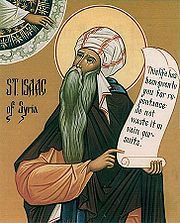
The Monk Isaac the Syrian, Bishop of Ninevah, lived during
the VII Century. Together with his brother he entered the monastery
of Mar Matthew. His learning and lofty ascetic manner of life
gained the notice of the brethren, and they proposed that he
head the monastery. The Monk Issac, not wanting this and instead
yearning for silence, withdrew from the monastery to an hermitage.
His brother more than once urged him to return to the monastery,
but the monk would not agree. However, when the fame of the holy
life of the Monk Isaac had spread all around, he was elevated
to the cathedra-chair of bishop of Ninevah. Seeing the crude
manners of the inhabitants of the city, the monk sensed that
it was beyond his ability to guide them, and moreover, he languished
for the quest of the hermit's life. All this was a burden for
the holy man, and in resigning as bishop, he withdrew into a
skete wilderness monastery. Here he lived until his death, attaining
to high spiritual perfection.
After the death of the Monk Isaac of Syria, from the early VIII Century through
the beginning XVIII Century, nothing was known about him in Europe except for
his name and works. Only in the year 1719 at Rome was there published a biography
of the monk, compiled by an anonymous Arab author. In 1896 the account about
the Monk Isaac was enlarged upon. The learned French soteriologist Abbot Charbot
published the works of the Syrian history of the VIII Century by Iezudena,
bishop of Barsa, wherein was located the account about the Monk Isaac the Syrian.
Translation of the relics of Hieromartyr Ignatius the God-bearer,
bishop of Antioch (107)
Commemorated on January 29/February 11
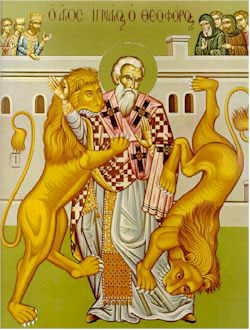
The
Transfer of the Relics of the PriestMartyr Ignatios the God-Bearer:
(the account
about him is located under 20 December).
After the holy PriestMartyr Ignatios was thrown for devouring
by wild beasts at Rome dying in the year 107 – on orders
of the emperor Trajan, Christians gathered up his bones and preserved
them at Rome. Later in the year 108 they were transferred to
the outskirts of Antioch. A second transfer – into the
city of Antioch itself, was done in the year 438. And after the
taking of Antioch by the Persians, the relics of the PriestMartyr
Ignatios were returned to Rome and placed into the church in
honour of the holy PriestMartyr Pope Clement in the year 540
(but according to other histories, the year was 637). The PriestMartyr
introduced antiphonal singing into Church Divine-services. He
has left us seven archpastoral epistles in which he provided
instruction on faith, love and good works, he urged likewise
the preserving of the oneness of the faith and to beware of heretics,
and he bid the obeying and honouring of bishops, "looking
upon the bishop as upon Christ Himself".
"Hearken ye unto the bishop, so that God in turn might hearken unto you...
let Baptism remain with you, like a shield and buckler; faith – like an
helmet; love – like a spear; patience – like full armour".
Synaxis of the Three Hierarchs: St. Basil the Great, St. Gregory
the Theologian, and St. John Chrysostom
Commemorated on January 30/February 12
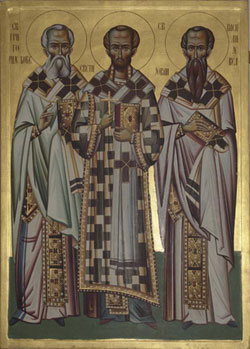
"Three Saints" – the
Assemblage (Sabor, Synaxis) of the Holy Ecumenical Teachers
of the Church and Sainted-Hierarchs:
Basil the Great, Gregory the Theologian and John Chrysostomos:
At Constantinople for a long time there raged disputes about
which one of the three sainted-hierarchs should be accorded the
primacy of honour. One faction of the people preferred Saint
Basil (Comm. 1 January), others stood forth for Saint Gregory
the Theologian (Comm. 25 January), while a third reverenced Saint
John Chrysostomos (Comm. 13 November).
From this arose among church factions amongst Christians: some
called themselves Basilians, others – Gregorians, and the third – Johannites.
In accord with the will of God, in the year 1084 the three sainted-hierarchs
appeared to the Euchantine metropolitan John, and in declaring that they were
equal before God, they gave orders that the disputes should stop and that a
day in common celebration of their memory should be established.
Holy Wonderworkers and Unmercenaries Cyrus and John (311)
Commemorated on January 31/February 13
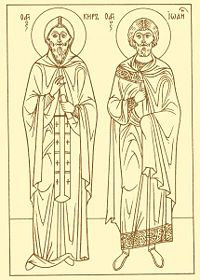
The Holy UnMercenary Cyrus was a noted physician in the city
of Alexandria, where he was born and grew up. He was a Christian
and he doctored all the sick for free, not only offering help
for bodily ills, but healing also infirmities of soul, such as
were causes of bodily sickness. Preaching the Gospel teaching,
the holy physician converted many pagans to Christ. During the
time of the persecution by Diocletian (284-305), Saint Cyrus
withdrew into the Arabian wilderness, where he took on the monastic
life, and continued there also to doctor people by his prayer,
having received from God the gift to heal every sickness.
In the city of Edessa at this time lived the soldier John, a
pious Christian. When the persecution started, he went to Jerusalem
and there, hearing about
Saint Cyrus, he began to search for him, and he went first to Alexandria and
then to Arabia. Having finally found Saint Cyrus, John with all his heart became
attached to him and became his faithful follower. They learned that in Egypt
in the city of Canopis had been arrested the Christian Athanasia and her three
young daughters: Theoktista – age 15, Theodotia – age 13, and Eudoxia – age
11. Saints Cyrus and John hastened to go to them in help, worrying that fear
in the face of torture might impel them to renounce Christ. They visited them
in prison and gave them courage to stand what was before them. Learning of
this, the governor of the city arrested Saints Cyrus and John, and convincing
himself of their steadfast and fearless confession of faith in Christ, he gave
them over to terrible tortures before the very eyes of Athanasia and her daughters,
who in turn bravely endured all the tortures and were beheaded. After them
at the same place they executed the holy UnMercenaries Cyrus and John (+ 311).
Christians buried their bodies in a church of the holy Disciple and Evangelist
Mark. In the V Century the relics of Saints Cyrus and John were transferred
from Canopis to Manuphin. Later on their relics were transferred to Rome, and
from there to Munchen (Munich) (an account further is located under 28 June).
Martyr Tryphon of Campsada near Apamea in Syria (250)
Commemorated on February 1/February 14
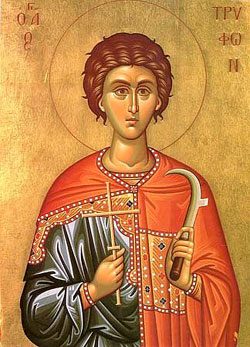
The
Martyr Tryphon was born in one of the districts of Asia Minor – Phrygia, not far from the city of Apameia in the
village of Kampsada. From his early years the Lord granted him
the power to cast out devils and to heal various maladies. The
inhabitants of his native city were once saved by him from starvation:
Saint Tryphon by the power of his prayer forced back a plague
of locusts that were devouring the bread grain and devastating
the fields. Saint Tryphon gained particular fame by casting out
a devil from the daughter of the Roman emperor Gordian (238-244).
Helping everyone in distress, he asked but one fee – faith
in Jesus Christ, by Whose grace he healed them.
When the emperor Decius (249-251) entered upon the imperial throne, there was
a fierce persecution of Christians. A denunciation was made to the commander
Akelinos that Saint Tryphon was bolding preaching faith in Christ and that
he led many to Baptism. The saint was arrested and subjected to interrogation,
at the time of which he fearlessly confessed his faith. They subjected him
to harsh tortures: they beat at him with clubs, lacerated his body with iron
hooks, they seared the wounds with fire, and led him through the city, having
hammered iron nails into his feet. Saint Tryphon bravely endured all the torments,
not giving out a single whimper. Finally, he was condemned to beheading with
a sword. The holy martyr prayed before the execution, thanking God for strengthening
him in his sufferings, and he besought of the Lord in particular to bless those
who should call upon his name for help. Just as the soldiers suspended the
sword over the head of the holy martyr, he placed his soul into the hands of
God. This event occurred in the city of Nicea in the year 250. Christians wound
the holy body of the martyr in a clean shroud and wanted to bury him in the
city of Nicea, in which he suffered, but Saint Tryphon in a vision commanded
them to take his body to his native land to the village of Kampsada. This was
done.
Later on the relics of Saint Tryphon were transferred to Constantinople, and
then to Rome. The holy martyr is accorded great veneration in the Russian Orthodox
Church.
There exists a legend, that during the reign of tsar Ivan the Terrible at the
time of an imperial hunt, a gerfalcon beloved by the tsar flew off. The tsar
ordered the falconer Tryphon Patrikeev to find the flown off bird. The falconer
Tryphon journeyed about through the surrounding forest, but without luck. On
the third day, exhausted by long searching, he returned to Moscow to the place
now called Mar'ina Grove, and in weariness he lay down to rest, fervently praying
to his patron saint – the Martyr Tryphon, beseeching him for help. In
a dream he saw a youth on a white horse, holding on his hand the imperial gerfalcon,
and this youth said: "Take back the lost bird, go with God to the tsar
and be not aggrieved about it". Having awakened, the falconer actually
spotted the gerfalcon not far off on a pine tree. He then took it to the tsar
and told about the miraculous help, received by him from the holy Martyr Tryphon.
After a certain while the falconer Tryphon Patrikeev built a chapel on the
spot where the saint appeared, and later on also there was a church in the
name of the holy Martyr Tryphon.
The Meeting of Our Lord, God and Saviour Jesus Christ
Commemorated on February 2/February 15
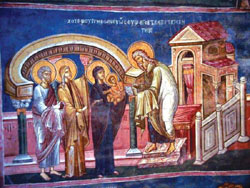
On
the Feast of the Meeting of the Lord, the Church commemorates
an important
event
in the earthly life of our Lord Jesus Christ
(Lk 2: 22-40). On the 40th day after birth the God-Infant was
taken to the Jerusalem Temple – the centre of religious
life of the God-chosen nation. By the Law of Moses (Lev 12) a
woman, having given birth to a child of the male gender, was
forbidden for 40 days to enter into the Temple of God. After
this interval the mother came to the Temple with the child, so
as to offer to the Lord thanksgiving and a purification sacrifice.
The MostHoly Virgin, the Mother of God, did not have need for
purification, since without defilement she had given birth to
the Source of purity and sanctity, but in profound humility she
submitted to the precepts of the Law.
At this time there lived at Jerusalem the righteous elder Simeon
(the account about him is located under the day of his commemoration – 3 February).
It had been revealed to him that he would not die until he should behold Christ
the Saviour. By inspiration from above, the pious elder went to the Temple
at that very moment when the MostHoly Mother of God and Righteous Joseph had
brought there the Infant Jesus, so as to fulfill the ritual ceremony of the
Law. The God-Bearer Simeon took the God-Infant in his arms, and having given
thanks to God, he uttered a prophecy about the Saviour of the world: "Now
lettest Thou Thy servant depart, O Lord, with peace according to Thy word,
wherefore hath mine eyes beheld Thy salvation, which Thou hast prepared before
the face of all peoples, a light to the enlightening of gentiles and the glory
of Thy people Israel" (Lk 2: 29-32). Righteous Simeon said to the MostHoly
Virgin: "Behold, This One is set for the fall and rising up of many in
Israel and for the sign spoken against, and for Thee Thyself a sword shalt
pierce the soul, so that the thoughts of many hearts might be revealed" (Lk
2: 35).
At the Temple also the 84 year old widow Anna the Prophetess, daughter of Phanuel
(Comm. 3 February), "who did not leave the temple, serving God both day
and night in fasting and prayer. And she also at that time, having drawn near,
glorified the Lord and spake about Him (the God-Infant) to all awaiting deliverance
at Jerusalem" (Lk 2: 37-38).
Before the Birth of Christ, all righteous men and women lived by faith in the
Future Messiah the Saviour of the world, and they awaited His coming. The final
righteous ones of the closing Old Testament – Righteous Simeon and the
Prophetess Anna – were deemed worthy to meet at the Temple the Bearer
of the New Testament, in the Person of Whom both Divinity and humanity do meet.
The Feast of the Meeting of the Lord is among the most ancient feasts of the
Christian Church. It is known, that on the day of this solemnity were proclaimed
sermons by Sainted Bishops Methodios of Patara (+ 312), Cyril of Jerusalem
(+ 360), Gregory the Theologian (+ 389), Amphylokios of Iconium (+ 394), Gregory
of Nyssa (+ 400), and John Chrysostom (+ 407). But in spite of its early origin,
this feast was not so solemnly celebrated until the VI Century. During the
reign of Justinian in the year 528, a catastrophe befell Antioch – an
earthquake, in which many people perished. And upon this misfortune there followed
others. In the year 544 there appeared a pestilential plague, daily carrying
off several thousand people. During these days of widespread travail, it was
revealed to a certain pious christian that the celebration of the Meeting of
the Lord should be done more solemnly.
When at the day of the Meeting of the Lord the all-night vigil was finally
made with church procession, the disasters at Byzantium ceased. In thanksgiving
to God, the Church established in 544 that the Meeting of the Lord should be
done more solemnly.
Church melodists adorned this feast with many a church work of song: in the
VII Century – Sainted Andrew ArchBishop of Crete; in the VIII Century – Sainted
Cosma Bishop of Maium, Monk John Damascene, Sainted Germanos Patriarch of Constantinople;
and in the IX Century – Sainted Joseph the Studite, ArchBishop of Thessalonika.
With the event of the Meeting of the Lord is associated the icon of the MostHoly
Mother of God named: "the Softening of Evil Hearts" or "Simeon's
Prophecy", which it is necessary to distinguish from the icon "Seven
Arrows".
The icon "Simeon's Prophecy" symbolises the fulfillment of the prophecy
of the righteous elder Simeon: "for Thee Thyself a sword shalt pierce
the soul" (Lk 2: 35).
Holy and Righteous Symeon the God-receiver and Anna the Prophetess
(1st c.)
Commemorated on February 3/February 16
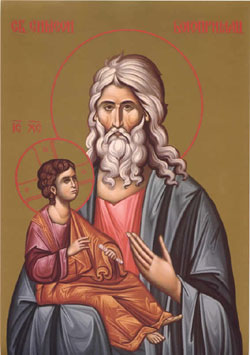
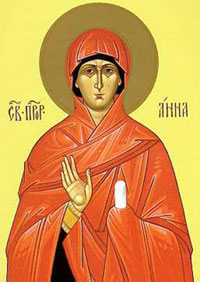
Righteous
Simeon the God-Receiver (Bogopriimets) was, according to the
testimony
of the holy Evangelist Luke, one of the chosen
of God in expectation of the consolation of Israel, and the Holy
Spirit dwelt upon him (Lk 2:25). It was announced to him from
God, that he would not die until that time, when the Promised
Messiah – Christ the Lord – would be come into the
world.
Ancient historians relate that the Egyptian emperor Ptolemy II
Philadelphos (285-247 BC) wished to add to the famous Library
at Alexandria with texts of
Holy Scripture. He invited scholars from Jerusalem, and the Sanhedrin sent
their wise men. Righteous Simeon was also among the 72 scholars in Alexandria
for the translation of the Sacred Scriptures into the Greek language. (The
work was accomplished and received the title "Translation of the 72 Interpreters".
With this also further on in the future, the New Testament was translated into
the Slavonic language for the Bulgarian, Serbian and Russian Orthodox Churches.)
Righteous Simeon translated a book of the Prophet Isaiah, having read in the
original the words: "Behold, a Virgin shalt conceive and give birth to
a Son" (Is 7: 14). He decided, that the word "Virgin" was incorrectly
used here in place of the word "Woman", and he wanted to correct
the text. At that moment an Angel appeared to him and held back his hand saying: "Have
faith in the words written down; thou thyself shalt be persuaded that they
will be fulfilled, whereof thou shalt not taste of death until thou behold
Christ the Lord, Who shall be born of a Pure and Immaculate Virgin".
From this day righteous Simeon began to await the coming of the Promised Messiah.
And here one day righteous Simeon, knowing of it by the Holy Spirit, was come
to the Jerusalem Temple. It was on that very same day (the fortieth after the
Birth of Christ), when the All-Pure Virgin Mary and Her Betrothed Joseph had
come there in order to perform the ritual set down by Jewish Law – to
present before the Lord His Own Divine First-Born and to offer the established
sacrifice.
When righteous Simeon beheld their arrival, the Holy Spirit revealed to him
that the God-Infant Whom the All-Pure Virgin Mary held, – was the Promised
Messiah, the Saviour of the world. The elder took into his arms the Infant
Christ and pronounced his prophetic words: "Now lettest Thou Thy servant
depart, O Lord, with peace according to Thy word, wherefore hath mine eyes
beheld Thy salvation, which Thou hast prepared before the face of all peoples,
a light to the enlightening of gentiles and the glory of Thy people Israel".
He blessed the All-Pure Virgin and Righteous Joseph and, having turned to the
Mother of God he said: "Behold, This One is set for the fall and rising
up of many in Israel and for the sign spoken against, and for Thee thyself
a sword shalt pierce the soul, so that the thoughts of many hearts might be
revealed" (Lk 2: 22-35).
The holy Evangelist relates further: "Here also was Anna the Prophetess,
daughter of Phanuel from the tribe of Aser, having reached extreme old age,
having lived with her husband for seven years, she was a widow for eighty-four
years, who went not out from the temple, serving God both day and night by
fasting and prayer. And she having approached at this time, glorified the Lord
and prophesied about Him to all awaiting deliverance at Jerusalem" (Lk
2: 36-38).
About the righteous and holy Simeon the God-Receiver is known that he died
in extreme old age. In the VI Century his holy relics were transferred to Constantinople.
Venerable Isidore of Pelusium, monk (436-440)
Commemorated on February 4/February 17
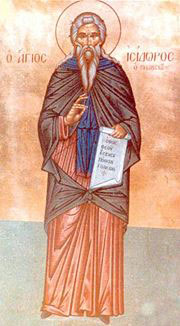
The
Monk Isidor Pelusiotes lived during the IV-V Centuries. He was
a
native of Alexandria,
and was raised amidst pious Christians.
He was a kinsman of Theophilos, Archbishop of Alexandria, and
of his successor, Saint Cyril. While still a youth he quit the
world and withdrew within Egypt to Mount Pelusiotes, which became
the site of his monastic efforts. The spiritual wisdom and strict
asceticism of the Monk Isidor, in combination with his broad
erudition and innate knowledge of the human soul, allowed him
in a short while to win the respect and love of his fellow monks.
They chose him as their head and had him elevated to the dignity
of presbyter. Following the example of Saint John Chrysostom,
whom he had managed to see and hear during the time of a journey
to Constantinople, the Monk Isidor devoted himself primarily
to Christian preaching, – that "practical wisdom" which,
in his own words, is both "the foundation of the edifice
and the edifice itself", while at the same time logic is "its
embellishment" and contemplation – its crown".
He was a teacher and a willing giver of counsel for anyone recoursing
to him for spiritual encouragement: whether it be a simple man,
a dignitary, a bishop, the Patriarch of Alexandria or even the
emperor himself. He left after him about 10,000 writings, of
which 2,090 have survived. A large portion of these writings
are profound in theological thought and contain morally edifying
interpretations of Holy Scripture. It is here that the Monk Isidor
stands out as the finest disciple of Saint John Chrysostom. The
love and devotion of the Monk Isidor for Saint John Chrysostom
resulted in decisive acts in defense of Saint John during the
time of his persecution by the empress Eudoxia and archbishop
Theophilos. After the death of Saint John, the Monk Isidor persuaded
Theophilos' successor Saint Cyril to inscribe the name of Saint
John Chrysostom into the Church diptyches as a confessor. And
through the initiative of the Monk Isidor was convened the Third
OEcumenical Council at Ephesus (431), at which was condemned
the false-teachings of Nestorius concerning the Person of Jesus
Christ.
The Monk Isidor lived into old age and died in about the year
436. The Church historian Euagrios (Evagrius, VI Century) writes
about the Monk Isidor, that "his
life seemed to everyone the life of an angel upon the earth". Another
historian, Nicholas Kallistos (IX Century), praises the Monk Isidor thus: "He
was a vital and inspired pillar of monastic rules and Divine vision and as
such he presented a very lofty image of most fervent example and spiritual
teaching".
Holy Martyr Agatha of Palermo in Sicily (251)
Commemorated on February 5/February 18

The
Holy Martyress Agatha was the daughter of rich and respected
Christian
parents
from the city of Palermo (formerly called Panorum)
in Sicily. During the time of the persecution under the emperor
Decius (249-251), the city governor of Catana, Centianus, – having
heard about the wealth and beauty of Agatha, sent his soldiers
after her to bring her to trial as a Christian. At Catana they
housed the saint with a certain rich woman, who had five daughters.
They all attempted to provide temptations for Saint Agatha by
means of fine clothes, amusements and entertainment, urging her
to offer sacrifice to the pagan gods, but the saint would not
give in to their tricks, and disdaining all the delights, she
prayed the Lord to grant her the strength for the act of martyrdom.
At the interrogation under Centianus, the holy martyress was
swayed neither by the flattery, nor by the threats, and she was
subjected to cruel jeering: they tore at her bosom with iron
hooks, and finally, they cut off her breasts. In prison the holy
Apostle Peter appeared to her and healed her of her wounds. Led
again to torture, Saint Agatha astonished Centianus, in that
her bosom was unharmed. They thereupon began to torture her anew.
At this moment in the city there began an earthquake, and the
earth opened up and swallowed the closest companions of Centianus.
The terrified inhabitants rushed to Centianus, demanding that
he stop the tortures. Fearing a revolt by the people, Centianus
sent Saint Agatha back to prison, where the martyress, in offering
up thanks to God, peacefully gave up her soul to the Lord.
St. Photius, patriarch of Constantinople (891)
Commemorated on February 6/February 19
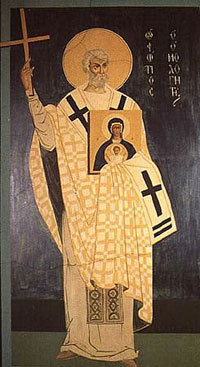
Sainted
Photios, Patriarch of Constantinople, lived during the IX Century,
and
came from a family of zealous Christians.
His father had died a martyr's death in defence of holy icons.
Saint Photios received an excellent education and, having family
relations with the imperial house, he occupied the position of
first state secretary in the Senate. His contemporaries said
of him: "He so distinguished himself with knowledge in almost
all the secular sciences, that it rightfully might be possible
to take into account the glory of his age and compare it with
the ancients". The young successor to the throne, Michael,
and the future Enlightener of the Slavs, the Equal-to the-Apostles
Cyril, were taught the sciences by him. Deep Christian piety
protected Saint Photios from being seduced with the charms of
court life – with all his soul he yearned towards monasticism.
In 857 the co-ruler with emperor Michael, Bardas, expelled Patriarch
Ignatios from the Constantinople cathedra-see. The bishops, knowing
the piety and extensive
knowledge of Photios, informed the emperor about him as a man worthy to occupy
the arch-pastoral throne. Saint Photios with humility accepted the proposal.
Over the course of 6 days he was led through the hierarchical positions, and
on the day of the Nativity of Christ he was ordained bishop with elevation
to the patriarchal throne. Soon however there began discord within the Church,
stirred up by the expulsion of Patriarch Ignatios from the cathedra. In the
year 861 there was convened a Council for ending of the unrest, and at which
was affirmed the deposition of Ignatios and the affirming of Photios as patriarch.
Pope Nicholas I, the envoys of whom were present at this Council, hoped by
affirming Photios as patriarch therein to subordinate him to his power, but
not having received what he expected, he betrayed Photios with an anathema
at a Roman Council. From that moment there began for Saint Photios, and lasting
to the very end of his life, his opposition to the papal bullying and enroachment
upon the Orthodox Church of the East. In 864 the Bulgarian land voluntarily
converted to Christianity. The Bulgarian prince Boris was baptised as they
proposed, by Patriarch Photios himself, after which Saint Photios dispatched
an archbishop and priests for the Baptism of the Bulgarian people, and in the
year 865 – Saints Cyril and Methodios were dispatched for the preaching
of Christ in the Slavonic language. But the partisans of the pope incited the
distrust of the Bulgarians towards the preachers of the Eastern Church. The
calamitous situation in Bulgaria because of an invasion by the Germans forced
them to seek help in the West, and the Bulgarian prince turned to the pope
with a request to send his bishops. Having arrived in Bulgaria, the papal legates
began actively to affirm there Latin teachings and useages in place of the
Orthodox. Saint Photios, being a firm defender of truth and denouncer of untruth,
informed the Eastern Church by means of a circular letter about the deeds of
the pope, indicating that the falling away of the Roman Church from its ancient
Orthodoxy was not only in rituals, but also in confession of faith. A Council
was convened, censuring the arrogance of the West.
In 867 Basil the Macedonian seized the imperial throne, having murdered the
emperor Michael. Saint Photios denounced the murderer and did not permit him
to partake of the Holy Mysteries of Christ. For this he was removed from the
patriarchal throne and locked up in a monastery under guard. In his place was
again put Patriarch Ignatios. A Council was convened for an investigation into
the conduct of Saint Photios: this Council was made with the participation
of papal legates, who demanded of the Council the signing of a document about
the unconditional subordination of all the Church to the judgement of the pope.
The Eastern bishops, not in agreement with this, entered into an argument with
the legates. Summoned to the Council, Saint Photios answered all the accusations
of the legates with silence, and only to the question of the judges as to whether
he wished to repent, did he reply: "Wherefore do ye consider yourselves
judges?" The opponents of Photios after long disputes gained the victory,
and their judgement being baseless, they pronounced an anathema upon Patriarch
Photios and the bishops defending him. The saint was sent to prison for 7 years,
and by his own testimony, "he thanked the Lord, for patiently enduring
His judges...".
During this period of time the Latin clergy were expelled from Bulgaria because
of the arrogance of the pope, and Patriarch Ignatios sent there his bishops.
In 679, after the death of Patriarch Ignatios, there was convened a Council
(many fathers of the Church call it the Eighth OEcumenical), and again Saint
Photios was acknowledged as the lawful pastor of the Church. Pope John, knowing
Photios personally, through his envoys declared at the Council the annulling
of all the former papal decisions about Photios. The Council acknowledged the
inalterable invariability of the Nicean-Constantinople Creed, rejecting the
Latin distortion ("filioque"), and it acknowledged the independence
and equality of both thrones and both Churches (Western and Eastern). The Council
decided to abolish in Bulgaria church useages and rituals introduced by the
Latins, which ended their governance there.
Under emperor Basil's successor, Leo, Saint Photios again suffered through
false denunciations, being accused of speaking against the emperor. Again deposed
from his cathedra-see in the year 886, the saint finished his days at the Armoneia
monastery in 891.
The Orthodox Church venerates Saint Photios as a zealous defender of the Orthodox
East from domination by the pope, and as a theologian, leaving behind him various
works, exposing the errors of the Latins, refuting various heresies, explicating
Holy Scripture, and exploring various topics of the faith.
Venerable Bucolus, bishop of Smyrna (ca. 100)
Commemorated on February 6/February 19
The Monk Bukolos, Bishop of Smyrna, was a disciple of the holy
Apostle and Evangelist John the Theologian, and was established
by him as the first bishop of the Smyrna Church (Asia Minor).
By the grace of God, Saint Bukolos converted to Christ and baptised many of
the pagans, and as an experienced and wise guide he defended his flock from
the darkness of heresy. He died at peace in about the years 100-105. He passed
his flock on to Saint Polycarp (Comm. 23 February), one of the apostolic fathers,
who likewise was a disciple of the holy Apostle John the Theologian. At the
grave of Saint Bukolos grew a myrtle tree, which healed the sick.
Great-martyr
Theodore Stratelates ("the General")
of Heraclea (319)
Commemorated on February 8/February 21
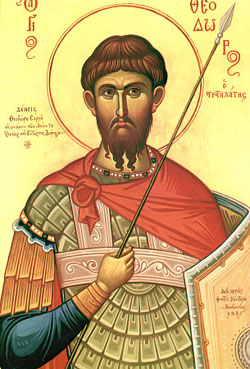
The
GreatMartyr Theodore Stratelates came from the city of Euchantum.
He was
endowed
with many talents and an handsome appearance.
For his charity God enlightened him with the perfective knowledge
of Christian truth. The bravery of the saintly soldier became
known to many after he, with the help of God, killed a giant
serpent living on a precipice in the surroundings of the city
of Euchantum. The serpent had devoured many people and animals,
holding in terror all the surrounding countryside. Saint Theodore,
having armed himself with a sword and a prayer to the Lord, vanquished
it, glorifying amongst the people the Name of Christ. For his
bravery Saint Theodore was appointed military-commander (stratelatos)in
the city of Heracleium, where he as it were carried out a dual
obedience, combining his official military service with an apostolic
preaching of the Gospel among the pagans subject to him. His
ardent persuasion, reinforced by his personal example of Christian
life, turned away many from the pernicious "false-gods".
Soon nearly all of Heracleium had accepted Christianity.
During this time the emperor Licinius (307-324) began a fierce persecution
against Christians. Wanting to decapitate the new faith, he resorted to making
persecution against the enlightened adherents of Christianity, in which not
without foundation he saw as the fundamental threat to the dying paganism.
Among such was also Saint Theodore. The saint himself invited Licinius to Heracleium,
having promised him to offer a sacrifice to the pagan gods. To make this splendid
ceremony, the saint requested to be gathered up at his house all the gold and
silver statues of the gods which they had in Heracleium.
Blinded by his hatred for Christianity, Licinius trusted the words of the saint.
But his expectations were cheated: having seized hold of the statues, Saint
Theodore smashed them into pieces which he then distributed to the poor. Thus
he shamed the vain faith in soulless idols and literally on the shards of paganism
he affirmed the laws of Christian charity. Saint Theodore was arrested and
subjected to fierce and refined torture. The witness was the servant of Saint
Theodore – Saint Varos, who barely found in himself the strength to write
down the incredible torments of his master. Sensing the nearness of death,
Saint Theodore yet turned to God with a last prayer, saying: "Lord, Thou
hast told me formerly, I am with thee, wherefore dost Thou now abandon me?
Behold, O Lord, how the wild beasts do tear at me on account of Thee, my eyes
are gored out, my flesh lacerated with wounds, the face is smashed and teeth
broken, and they have my bared bones on a cross: remember me, O Lord, having
suffered a cross on account of Thee, the iron and fire, and being raised up
on nails for Thee: wherefore accept my spirit, since my life doth expire".
God however, by His great mercy, willed that the end of Saint Theodore should
be as fruitful for those near him as was his life: He healed the bruised body
of the saint and brought him down from the cross, on which he had been left
all night. In the morning the imperial soldiers found him alive and unharmed;
persuaded in their own eyes of the infinite might of the Christian God, they
right there, not far from the place of the unsuccessful execution, accepted
holy Baptism. Thus Saint Theodore became "like a day of splendour" for
those pagans dwelling in the darkness of idol-worship and he enlightened their
souls "with the bright rays of his suffering". Not wanting to flee
a martyr's death for Christ, Saint Theodore voluntarily gave himself over into
the hands of Licinius, preventing the people believing in Christ from rising
up against the torturer, with the words: "Beloved, halt! My Lord Jesus
Christ, hanging upon the Cross, held back the Angels and did not permit them
to take revenge on the race of man". Going to execution, the holy martyr
with but a word opened up the prison doors and liberated those locked up from
their bonds. The people also who touched at his robe were restored of body,
healed instantly from sicknesses and freed from demons. By order of the emperor,
Saint Theodore was beheaded by the sword. Before the death by execution he
told Varos: "Neglect not to write down the day of my death, and put my
body in Euchantum". Together with these words he asked for an annual remembrance.
Then, having said "amen", he bent his neck beneathe the sword. This
occurred on 8 February 319, on a Saturday, at the third hour of the day.
Prophet Zechariah, from among the 12 Minor Prophets (520 BC)
Commemorated on February 8/February 21
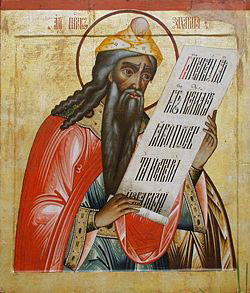
The
Prophet Zechariah (Zakhariah) the Sickle-Seer from amongst the
12 Minor
Prophets
was descended from the Levite tribe, called
in the Book of Nehemiah-Ezra the chief priestly lineage. He was
called to prophetic service at a young age and became, in the
wondrous expression of churchly song, "a spectator of supra-worldly
visions". In particular within the Book of the Prophet Zechariah
there is contained inspired details about the coming of the Messiah
(6: 12); about the last days of the earthly life of the Saviour,
and about the Entry of the Lord into Jerusalem on a young donkey
(9: 9); about the betrayal of the Lord for 30 pieces of silver
and the purchase with them of the potter's field (11: 12-13);
about the piercing of the side of the Saviour (12: 10); about
the scattering of the apostles from the Garden of Gethsemane
(13: 7); about the sun's eclipse at the time of the sufferings
on the Cross of the Saviour (14: 6-7). "Enlightened by dawnings
all above", the Prophet Zechariah "saw the future as
the presently existing". According to tradition, this "most
true God-proclaimer" lived to old age and was buried not
far from Jerusalem, alongside his illustrious contemporary and
companion the Prophet Haggai. The title "Sickle-Seer" given
Zechariah is connected to one of the revelations to him, in which
he saw a scroll flying in the air, curved to the likeness of
a menacing sickle (5: 1-2).
St. Sabbas II, archbishop of Serbia (1271)
Commemorated on February 8/February 21
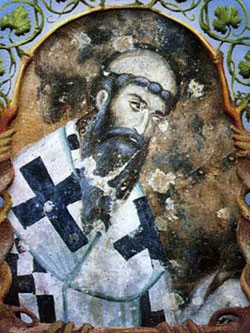
He was the youngest son of the first crowned king of Serbia
Stephen and the nephew of Sava IV. In youth he accepted monasticism
and ascetically struggled first in Jerusalem, and then on Mount
Athos. From here he was called to Serbia and was installed as
the archbishop of his native land. St. Sava ruled over the Serbian
Church for about seven years and died in peace in 1268 or 1269.
St. Sava is known for his special meekness and humility. His
relics are in the Serbian monastery in Pec.
Martyr Nicephorus of Antioch (ca. 257)
Commemorated on February 9/February 22
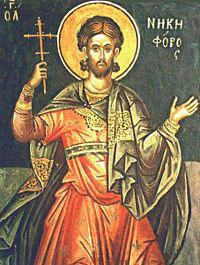
The Holy Martyr Nicephoros lived in the city of Syrian Antioch.
In this city lived also the presbyter Sapricios, with whom Nicephoros
was very friendly, such that they were considered like kindred
brothers. Through the onset of a disagreement they quarreled,
and their former love changed into enmity and hate. After a certain
while Nicephoros came to his senses, repented of his sin and
more than once through mutual friends asked forgiveness of Sapricios,
who did not wish to forgive him. Nicephoros then went himself
to his former friend and fervently asked forgiveness, but Sapricios
was adamant. At this time the emperors Valerian (253-259) and
Gallius (260-268) started up persecutions against christians,
and one of the first taken before the judgement court was presbyter
Sapricios. He firmly confessed himself a Christian, underwent
tortures for his faith and was condemned to death by beheading
with a sword. When they took him to execution, Nicephoros tearfully
entreated his forgiveness, calling on him as an holy martyr who
would soon stand before the Lord and receive of Him a crown.
But presbyter Sapricios remained hardened of heart and even before
death he refused to forgive his brother-christian. Because of
this the Lord withheld
His blessing from Sapricios, having formerly strengthened him during the time
of enduring torture; but now, having nearly reached the blessed end of his
ordeal, he suddenly became afraid of death and consented to offer sacrifice
to idols. In vain did Saint Nicephoros tearfully urge on Sapricios, that he
not destroy himself by apostasy, since already he was standing at the threshold
of the Heavenly Kingdom. Saint Nicephoros then said to the executioner: "I
am a Christian and I believe in our Lord Jesus Christ, from whom Sapricios
hath recanted. Execute me in place of Sapricios". The executioners reported
about this to the governor. He issued an edict: to free Sapricios, and in place
of him to behead Nicephoros with a sword. Thus did Saint Nicephoros receive
his martyr's crown.
Hieromartyr Charalampus, bishop of Magnesia in Thessaly, and
Martyrs Porphyrius and Baptus (202)
Commemorated on February 10/February 23
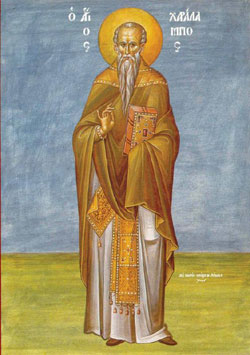
The PriestMartyr Charalampios, Bishop of Magnezia, the Martyrs
Porphyry and Baptos and the Three Martyresses suffered in the
year 202.
Saint Charalampios, bishop of the Thessalonian city of Magnezia
(northwest region of Greece), successfully spread faith in Christ
the Saviour. News about
his preaching reached the governor of the district Lucian and the military-commander
Lucius. The saint was arrested and brought to trial, where he firmly confessed
his faith in Christ and refused to offer sacrifice to idols. Despite the decrepit
age of the bishop (he was already 113 years of age), they subjected him to
monstrous tortures: they lacerated his body with iron hooks, while they scourged
all his skin from head to foot. During this the saint turned to his tormentors: "I
bless you, brethren, ye have restored my spirit!"
Having seen the endurance of the elder and his complete lack of malice, two
soldiers – Porphyry and Baptos openly confessed Christ, for which they
were immediately beheaded with a sword. Being present at the sufferings of
bishop Charalampios were likewise three women who began to glorify Christ and
were quickly martyred.
The enraged Lucius himself seized hold of the instruments of torture and began
to tear at the priest-martyr, but suddenly his hand was cut off as though by
a sword. Also arriving at the place of execution the governor spat in the face
of the saint, and immediately he bent backwards. Then Lucius began to beseech
the saint for forgiveness, and through his prayer both torturers at once received
healing. During this a multitude of witnesses came to believe in Christ. Among
them also was Lucius, who fell at the feet of the holy elder, begging forgiveness.
Lucian reported about the occurrence to the emperor Septimus Severus (193-211),
situated at this time at Pisidian Antioch (western part of Asia Minor). The
emperor gave orders to bring Saint Charlampios to him, and this was done with
a stupid ferocity: they dragged the priest-martyr, having tied a rope to his
beard. The emperor then gave orders to torture the bishop more intensely, and
they began to burn at him with fire. But the Power of God aided to the saint,
and he remained unharmed. Besides this, miracles were done through his prayer:
he raised up a dead youth, and healed a demoniac tormented by devils for 35
years, so that the people in a multitude began to believe in Christ the Saviour.
Even Galina the daughter of the emperor began to believe in Christ, and twice
smashed idols in a pagan temple. By order of the emperor they beat the saint
with stones about the mouth, and they wanted to set afire his beard, from which
the flames went forth burning the torturer. Full of wickedness, Septimus Severus
and his dignitary Crispus hurled blasphemy at the Lord, mockingly summoning
Him to come down to the earth, and bragging of their own power and might. In
wrath the Lord quaked the earth, great fear fell upon all, both the impious
ones were suspended in mid-air held by invisible bounds, and only by the prayer
of the saint were they put down. The dazed emperor was shaken in his former
impiety, but again quickly fell into error and gave orders to torture the saint.
And finally, he sentenced him to beheading with a sword. During the time of
his final prayer, the saint was vouchsafed to behold the Saviour Himself and
besought Him to grant that place where his remains would repose, in peace,
would be fruitful for people, bringing forgiveness of sins and salvation. The
Lord promised to fulfill the request and ascended to heaven, bearing with Him
the soul of the priestmartyr Charalampios – who through the mercy of
God accepted a peaceful death before execution. The daughter of the emperor,
blessed Galina, buried the body of the martyr with great honour.
Hieromartyr Blaise, bishop of Sebaste (316)
Commemorated on February 11/February 24
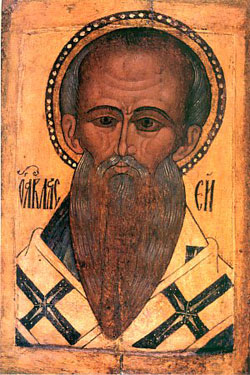
The
PriestMartyr Blaise (Blasios), Bishop of Sebasteia, was known
for his righteous
and pious life. He was unanimously chosen
by the people and ordained bishop of Sebasteia. This occurred
during the reign of the Roman emperors Diocletian (284-305) and
Licinius (307-324) – fierce persecutors of Christians.
Saint Blaise had to encourage his flock, visit the imprisoned,
and give support to the martyrs.
Many hid themselves away from the persecutors by going off into desolate and
solitary places. Saint Blaise likewise took the opportunity to hide himself
away on Mount Argeos, where he asceticised in a cave. Wild beasts came up to
him and meekly waited until the saint finished his prayer and gave them blessing;
the saint likewise healed sick animals by laying his hands upon them. The refuge
of the saint was discovered by servants of the governor Agricolaus, being in
the area to snare wild beasts to use to tear apart the Christian martyrs. The
servants reported to their master that Christians were hidden away on the mountain,
and he gave orders to arrest them. But those sent out found there only the
Sebasteia bishop. Glorifying God Who had summoned him to this exploit, Saint
Blaise followed the soldiers.
Along the way the saint healed the sick and worked other miracles. Thus, a
destitute widow complained to him of her misfortune: a wolf had carried off
her only possession – a small pig. The bishop smiled and said to her: "Weep
not, thine piglet wilt be returned to thee...". And actually to the astonishment
of everyone, the wolf came running back and returned his booty unharmed.
Agricolaus, greeting the bishop with words of deceit, called him a companion
of the gods. The saint answered the greeting, but the gods he called devils.
Then they gave him a fierce beating and led him off to prison.
On the next day they again subjected the saint to tortures. When they led him
back to the prison, seven women went along behind and gathered up the drops
of blood. These they arrested and tried to compel them to worship the idols.
The women in pretending to consent to this said, that they needed cleansing
beforehand in the waters of a lake. They took along the idols and submerged
them in a very deep portion of the lake, and after this the Christians were
fiercely tortured. The saints stoically endured the torments, strengthened
by the grace of God, their bodies were transformed and became white like snow,
and together with the blood there flowed what seemed like milk. One of the
women had two young sons, who implored their mother that she help them attain
the Kingdom of Heaven and she entrusted them into the care of Saint Blaise.
The seven holy women were then beheaded.
Saint Blaise was again brought before Agricolaus, and again he unflinchingly
confessed his faith in Christ. The governor gave orders to throw the martyr
into a lake. The saint, going down to the water, signed himself with the Sign
of the Cross, and he went about on it as though on dry land. Addressing the
pagans standing about on shore, he challenged them to come to him whilst calling
on the help of their gods. To this, 68 men of the governor's retinue made bold
and entered the water, and all immediately drowned. The saint, however, heeding
the Angel that had appeared to him, returned to shore.
Agricolaus was in a rage over having lost his finest servants, and he gave
orders to behead Saint Blaise, and together with him the two boys entrusted
to him, the sons of the martyress. Before death, the priestmartyr prayed for
all the whole world, and especially for those honouring his memory. This occurred
in about the year 316. The relics of the PriestMartyr Blaise were carried off
to the West during the time of the Crusades, and portions of the relics are
preserved in many of the lands of Europe [and his memory traditionally honoured
there on 3 February].
St. Meletius, archbishop of Antioch (381)
Commemorated on February 12/February 25
Saint Meletios, Archbishop of Antioch, was at first a bishop of Sebasteia in
Armenia (c.357), and afterwards he was summoned by the emperor Constantius
to Antioch to help defend against the Arian heresy, and received there the
cathedra-seat.
Saint Meletios struggled quite zealously against the Arian error, but through
the intrigues of the heretics he was thrice deposed from his cathedra-seat;
Constantius had become surrounded by the Arians and had been swayed over to
their position. In all this Saint Meletios was distinguished by an extraordinary
gentleness, and he constantly led along his flock by the example of his own
virtue and kindly disposition, presupposing that upon suchlike a soil sprouts
more readily the seeds of the true teaching of the faith.
Saint Meletios was the one who ordained as deacon the future hierarch Saint
Basil the Great. And Saint Meletios also baptised and encouraged the growth
under him of another of the greatest luminaries of Orthodoxy – Saint
John Chrysostom, who afterwards wrote an eulogy to his former archpastor.
After Constantius, the throne was occupied by Julian the Apostate, and the
saint again was expelled, having to hide himself away in secret places for
his safety. But again returning under the emperor Jovian in the year 363, Saint
Meletios wrote his theological tract, "Exposition of the Faith",
which facilitated the conversion to Orthodoxy of many of the Arians.
In the year 381, under the emperor Theodosius the Great (379-395), the Second
OEcumenical Council was convened. Already in the year 380 the saint had set
off on his way to the Second OEcumenical Council at Constantinople, and came
to preside over it. Before the start of the Council, Saint Meletios raised
up his hand displaying three fingers, and then conjoining together two fingers
and bending the one he blessed the people, proclaiming: "We apprehend
three hypostatic-persons, and we speak about one self-same nature," – and
with this declaration of the saint there flashed the fire of a lightning-bolt.
During the time of the Council Saint Meletios expired to the Lord. Saint Gregory
of Nyssa honoured the memory of the deceased with an eulogistic word.
There are preserved discourses of Saint Meletios concerning the One-in-Essence
nature of the Son of God with God the Father, and also his letter to the emperor
Jovian about the confessing of the Holy Trinity. The relics of Saint Meletios
were transferred from Constantinople to Antioch.
Venerable Symeon the Myrrh-gusher, prince of Serbia (1200)
Commemorated on February 13/February 26
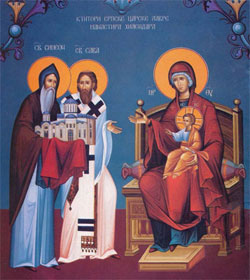
The
Monk Simeon the Myrh-Exuding, Tsar of Serbia, was in the world
the
Great "Zhupan" (prince) of Serbia, and had
the name Stefan Nemany (Nemanya). He lived during the XII Century.
The prince toiled much for his fatherland: he united a large
portion of the Serb lands and strove for the political independence
of his country. He zealously defended his nation against the
incursions of Latinism and heresies. At age 80 Stefan set off
to Athos, where his son – the Monk Savva (Comm. 12 January),
was glorified by holiness of life. Together there they restored
the desolate Khilendaria monastery, to which monks from various
lands began to gather. Saint Simeon was a great ascetic and wise
guide for the monks. The Monk Simeon died on 13 February 1200.
His relics began to exude myrh. The Monk Savva transported the
remains of his father back to their native land, to Serbia, and
placed them in a church of the MostHoly Mother of God situated
at the River Studenitsa. Saint Simeon while still the prince
had erected and richly adorned this church.
Venerable Auxentius, monk of Bithynia (470)
Commemorated on February 14/February 27
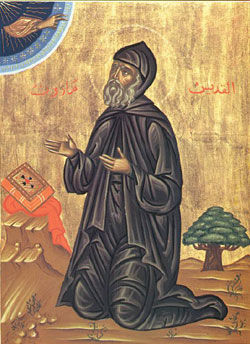
The Monk Auxentios, by origin a Syrian, served at the court
of the emperor Theodosius the Younger (418-450). He was known
as a virtuous, learned and wise man, and he was moreover a friend
of many of the pious men of his era.
Distressed by worldly vanity, Saint Auxentios accepted the dignity of presbyter,
and then received monastic tonsure. Setting off after this to Bithynia, he
found a solitary place on Mount Oxus, not far from Chalcedon, and there he
began the life of an hermit. (This mountain was afterwards called Auxentian).
The place of the saint's efforts was stumbled upon by shepherds, seeking after
lost sheep. They spread the news about him, and people began to come to him
for healing. With the Name of God, Saint Auxentios healed many of the sick
and the infirm.
In the year 451 Saint Auxentios was invited to the Fourth OEcumenical Council
at Chalcedon, where he became known as a denouncer of the Eutykhian and Nestorian
heresies. He was greatly familiar with Holy Scripture, and Saint Auxentios
easily bested those opponents who entered into dispute with him. After the
finish of the Council, Saint Auxentios returned again to his solitary cell
on the mountain. By means of spiritual sight he saw the end of Saint Simeon
the Pillar-Dweller (459), from over a great distance.
The Monk Auxentios himself died in about the year 470, leaving behind him disciples
and many monasteries constructed in the Bithynian region.
St. Cyril, Equal-to-the-Apostles, teacher of the Slavs (869)
Commemorated on February 14/February 27
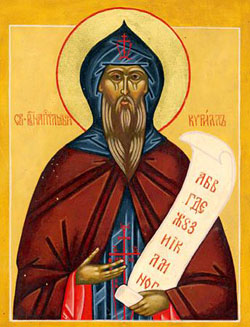
The
Holy Equal-to-the-Apostles Cyril, Teacher of the Slavs (named
Constantine – upon
his assuming of the Schema), and his older brother Methodios
(Comm. 6 April), were by descent
Slavs, born in Macedonia in the city of Soluneia (Thessalonika).
Saint Cyril received the finest of educations, and from age 14
he was raised together with the son of the emperor. He early
accepted the dignity of presbyter. Upon his return to Constantinople,
he worked as a librarian of the cathedral church, and as a professor
of philosophy. Saint Cyril successfully held debates with iconoclast
heretics and with Mahometans. Yearning for solitude, he set off
to Mount Olympos to his older brother Methodios, but his solitude
lasted only a short while. Both brothers were dispatched by the
emperor Michael in the year 857 on a missionary journey to preach
Christianity to the Khozars. Along the way they stopped off at
Cherson and discovered there the relics of the PriestMartyr Clement,
Pope of Rome (Comm. 25 November). Arriving at the Khozars, the
holy brothers spoke with them about the Christian faith. Persuaded
by the preaching of Saint Cyril, the Khozar prince together with
all his people accepted Christianity. The grateful prince wanted
to reward the preachers with rich presents, but they refused
this and instead asked the prince to free and send home with
them all the Greek captives. Saint Cyril returned to Constantinople
together with 200 such captives set free.
In the year 862 began the chief exploit of the holy brothers.
At the request of prince Rostislav, the emperor sent them to
Moravia for preaching Christianity
in the Slavic language. Saints Cyril and Methodios by a revelation from God
compiled a Slavonic alphabet and translated into the Slavonic language – the
Gospel, Epistles, the Psalter and many Divine-service books. They introduced
Divine-services in the Slavonic tongue. The holy brothers were then summoned
to Rome at the invitation of the Roman pope. Pope Adrian received them with
great honour, since they brought with them the relics of the PriestMartyr Clement,
Pope of Rome. By nature sickly and of weak health, Saint Cyril from his many
labours soon fell ill, and having taken the schema, he died in the year 869
at age 42. Before his death, he expressed last-wishes for his brother to continue
with the Christian enlightenment of the Slavs. Saint Cyril was buried in the
Roman church of Saint Clement, whose own relics also rest there, brought to
Italy from Cherson by the Enlighteners of the Slavs.
Apostle Onesimus of the Seventy (109)
Commemorated on February 15/February 28
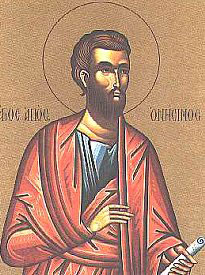
The Disciple from the 70 Onysimos in his youth was a servant
of Philemon, a Christian of distinguished lineage, living in
the city of Phrygian Colossa. Guilty of an offense against his
master and fearing punishment, Saint Onysimos fled to Rome, but
as a runaway slave he wound up in prison there. In prison he
encountered the Apostle Paul held in chains, was enlightened
by him and accepted holy Baptism. In prison Saint Onysimos served
the Apostle Paul like a son. The Apostle Paul was personally
acquainted with Philemon, and wrote him a letter filled with
love, asking him to forgive the runaway slave and to accept him
like a brother; he dispatched Saint Onysimos with this letter
to his master, depriving himself of help, in which he was very
much in need.
Saint Philemon, having received the letter, not only forgave Onysimos, but
also dispatched him to sail back to Rome to the first-rank apostle. Saint Philemon
was afterwards ordained bishop of the city of Gaza (Comm. 4 January, 19 February
and 22 November).
After the death of the Apostle Paul, Saint Onysimos served the apostles until
their end, and he was ordained bishop by them. After the death of the holy
apostles he preached the Gospel in many lands and cities: in Spain, Carpetania,
Colossa, Patras. In his old age, Saint Onysimos occupied the bishop's throne
at Ephesus, in succession after the Disciple Timothy. When they took Ignatios
the God-Bearer to Rome for execution, Bishop Onysimos came to meet with him
with certain Christians, about which Saint Ignatios makes mention in his Epistle
to the Ephesians.
During the reign of the emperor Trajan, Saint Onysimos was arrested and brought
to trial before the eparch Tertillus. He held the saint for 18 days in prison,
and then sent him for imprisonment to the city of Putiola. After a certain
while, the eparch sent for the prisoner and, convincing himself that Saint
Onysimos quite firmly confessed his faith in Christ, had him subjected to a
fierce beating with stones, after which they beheaded the saint with a sword.
A certain illustrious woman took the body of the martyr and placed it in a
silver coffin. This was in about the year 109.